Allison Collection Photos
February, 1942
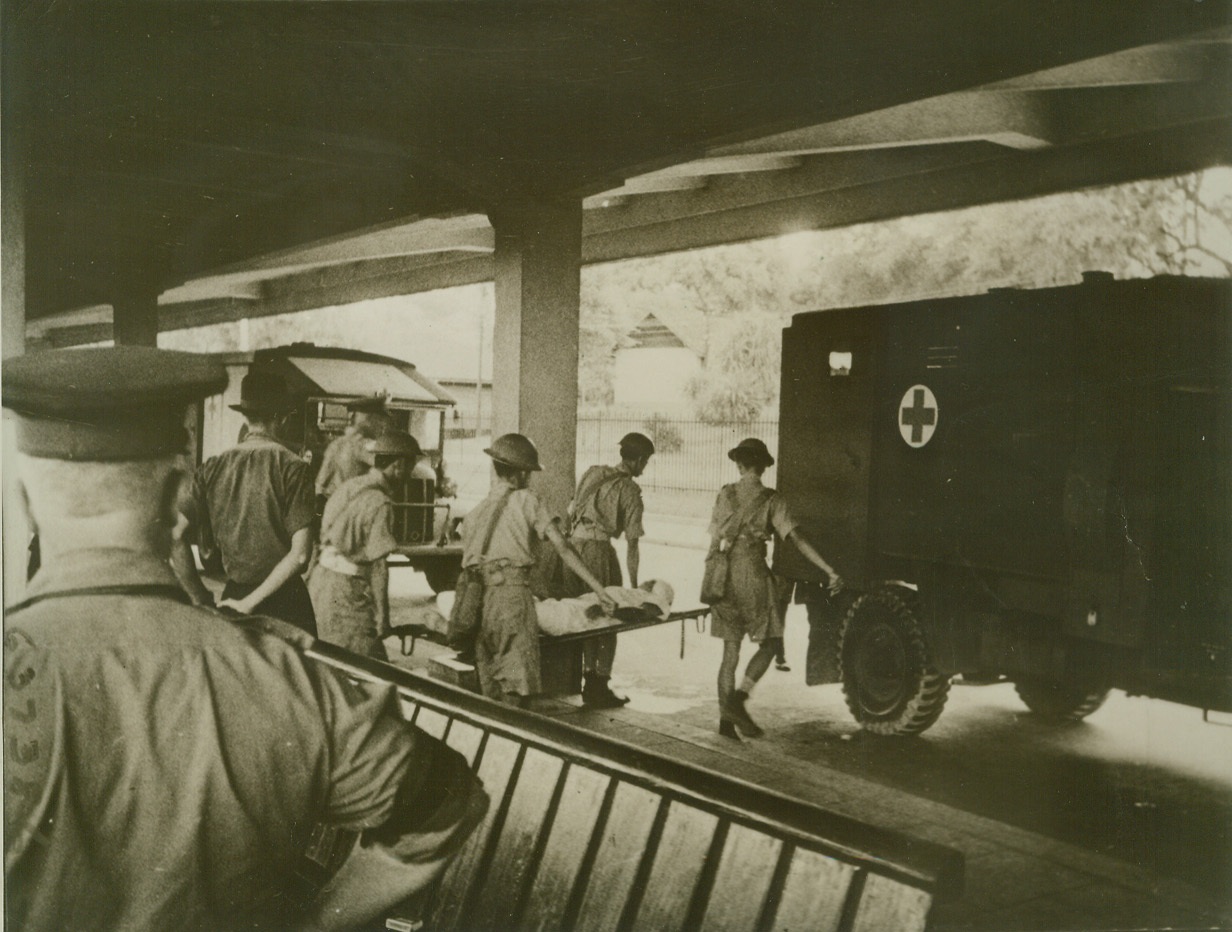
MALAYAN CHINESE HELP BRITISH WOUNDED, 2/11/1942. MALAYA – Chinese stretcher bearers carry a wounded British soldier to a waiting ambulance outside a Malayan station. Many Chinese served in this capacity during the Malayan campaign. Credit: ACME;
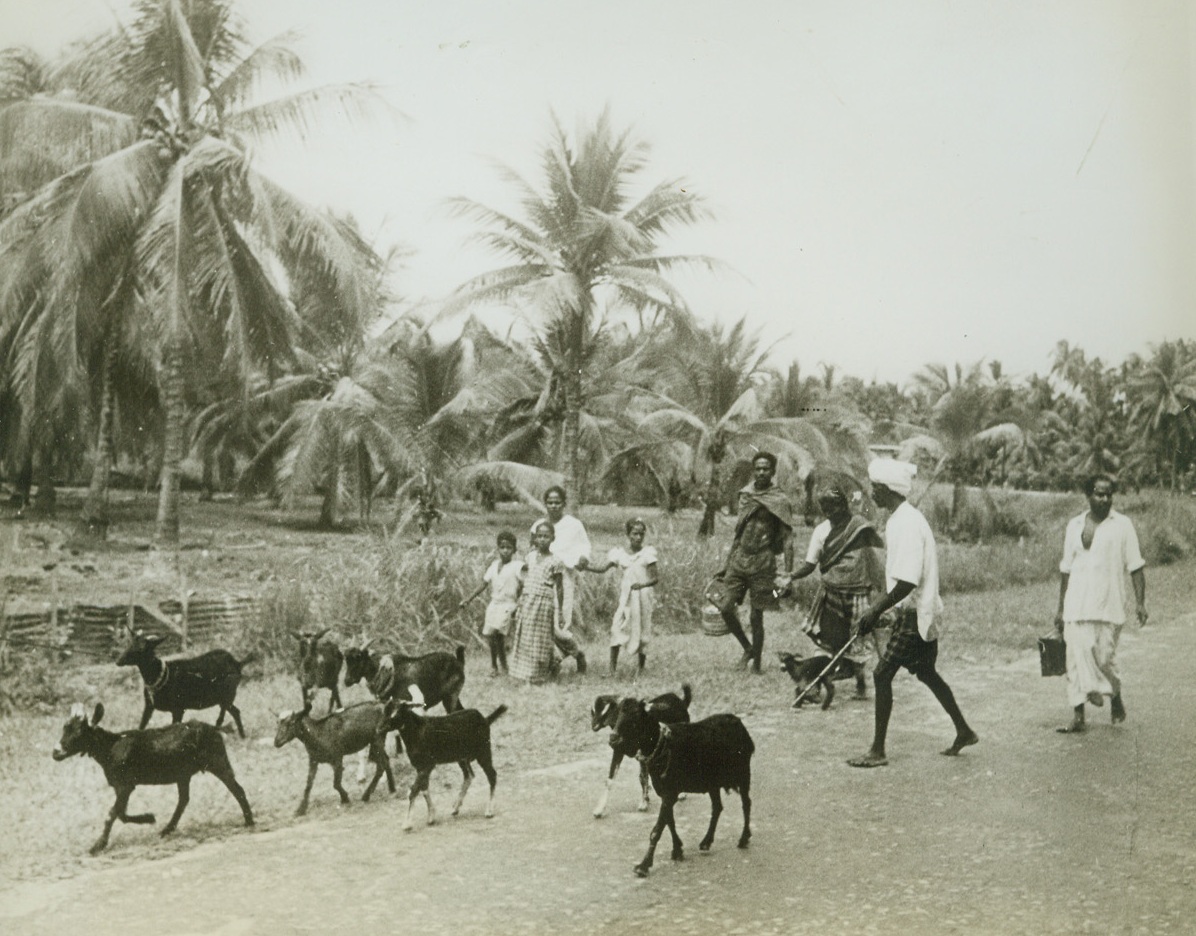
Malayan Natives Don’t Like Japs, 2/11/1942. Malaya—Malayan natives, with their possessions, are shown moving along, out of possible reach of the Japanese. Japanese forces outside the city of Singapore are meeting strong resistance from Imperial troops.Credit Line (ACME);
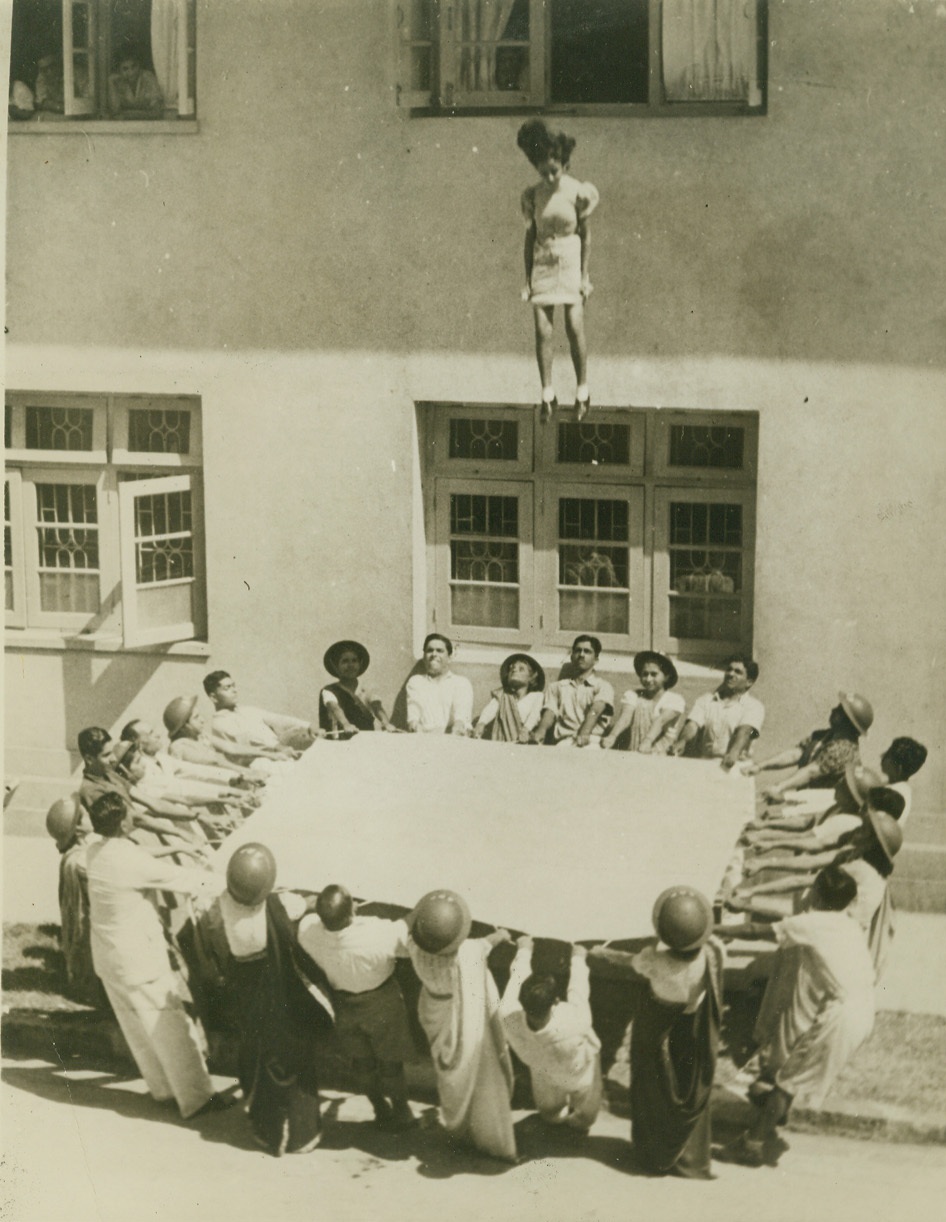
ALL INDIA JOINS IN DEFENSE, 2/13/1942. BOMBAY, INDIA – Realizing the nearness of the war to them, Indians are joining in an all-out effort to prepare for emergencies that might come. Just as in other countries, women, too, are training to do their part, and here a group of Parsee women, members of the ancient Zoroastrian sect, practice rescues that may follow air raids, in an A.R.P. class at the Cusrow Baug School. Credit: ACME;
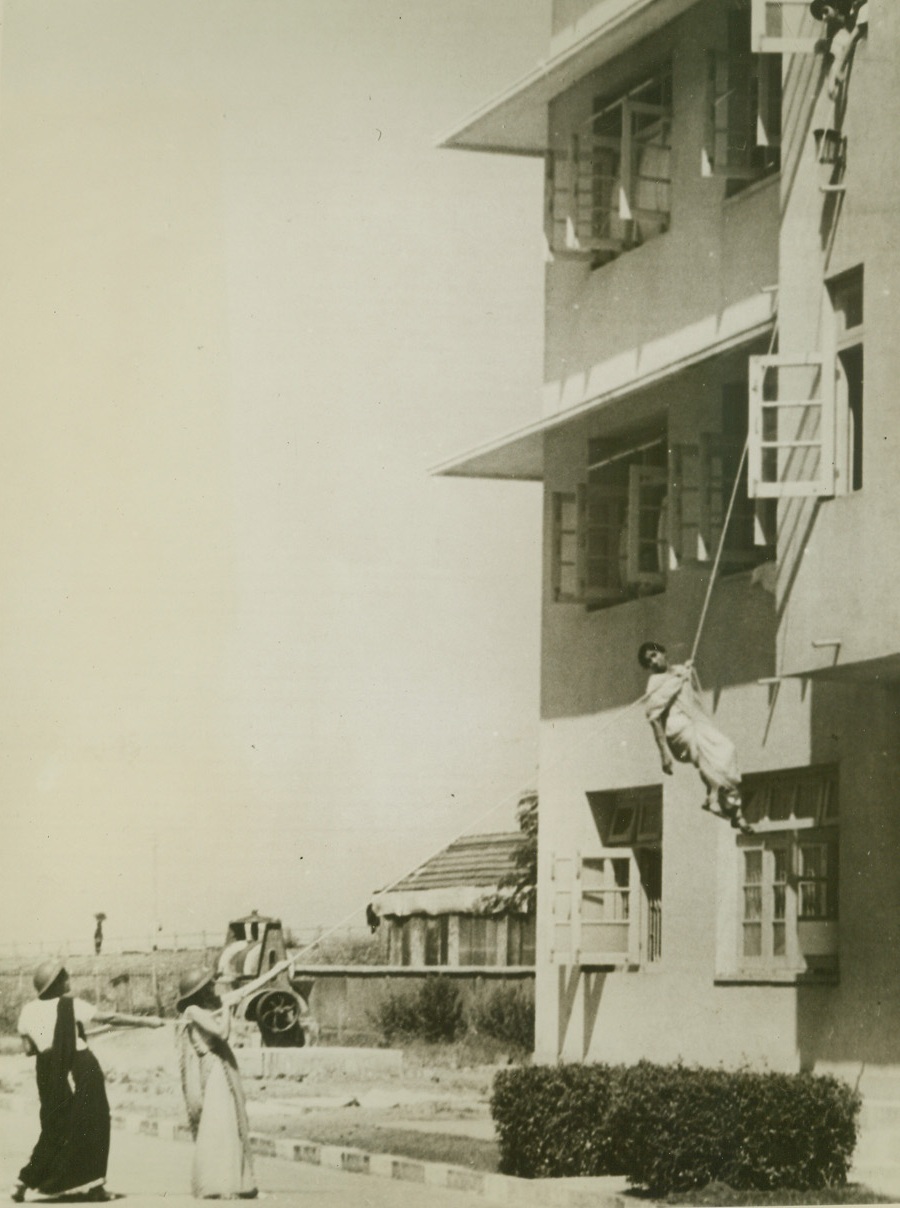
LL INDIA JOINS IN DEFENSE, 2/13/1942. BOMBAY, INDIA—Realizing the nearness of the war to them, Indians are joining in an all-out effort to prepare for emergencies that may come. Just as in other countries, women, too, are training to do their part, and here a group of Parsee women, members of the ancient Zoroastrian sect, practice lowering an air raid victim from a damaged building by means of a chair-knot. This method is only used when the fictim has not lost consciousness.Credit: Acme;
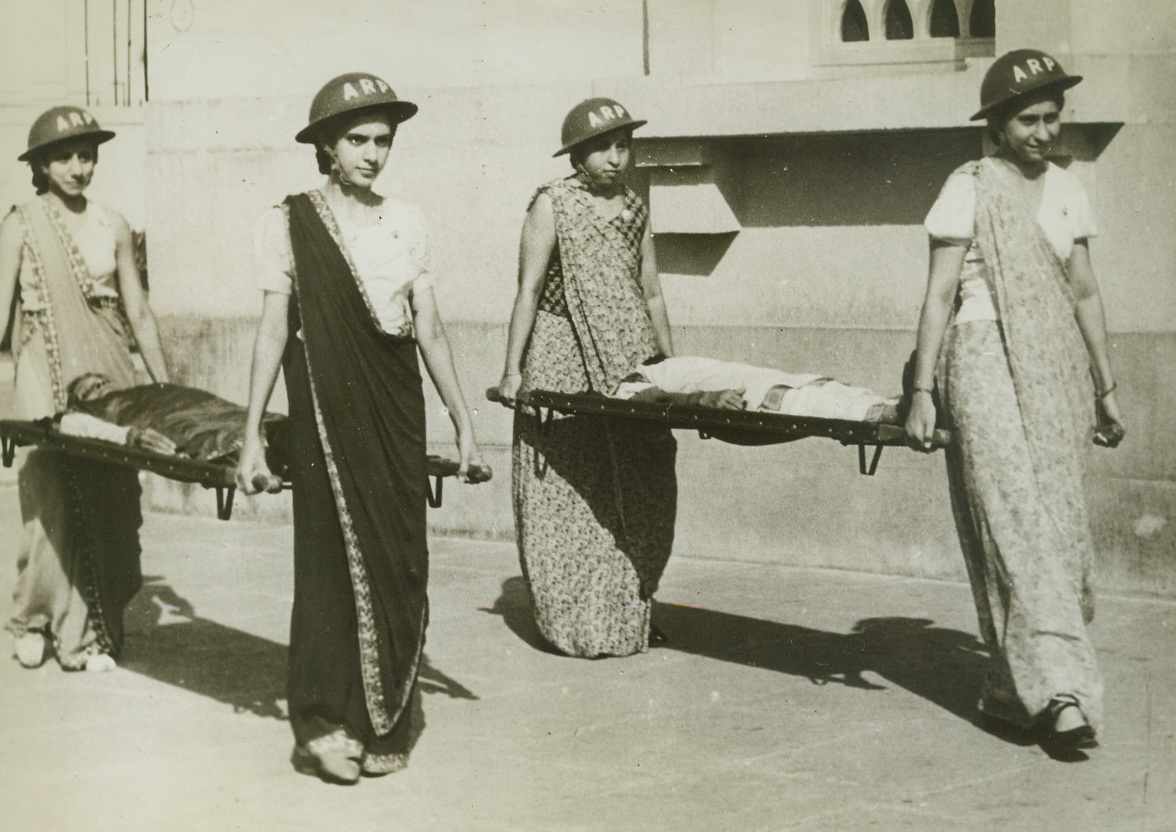
All India Joins In Defense, 2/13/1942. Bombay, India -- …..Just as in other countries, women, too, are training to do their part, and here an air raid precautions glass of Parsee women, members of an ancient Zorastrian sect, practice removing causalities of air raids on stretchers, at the Cusrow Raug class. Credit Line (ACME);
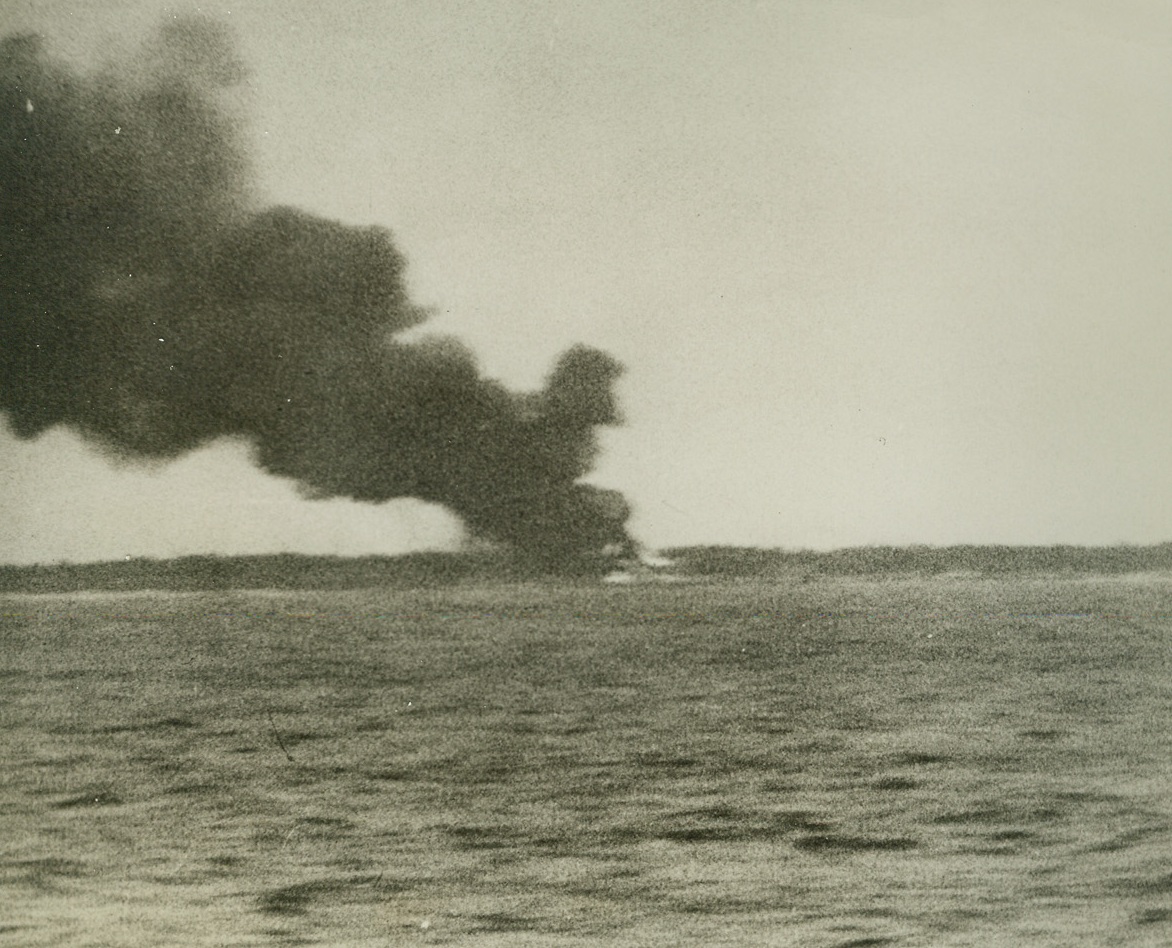
As U.S. Navy Struck Back, 2/14/1942. With the Pacific Fleet – Smoke rises from Wotje Atoll, one of the Marshall and Gilbert island group in the Western Pacific, testifying to the marksmanship of gunners and bombers who took part in the U.S. Navy’s first powerful counter-blow at Japanese territory. Damage on Wotje included the firing of hangars, fuel stores and munition dumps, and the sinking of a number of vessels anchored offshore. This picture, among the first of the Pacific success, was made from aboard one of the attacking cruisers.Credit Line: Pathe Newsreel (from ACME);
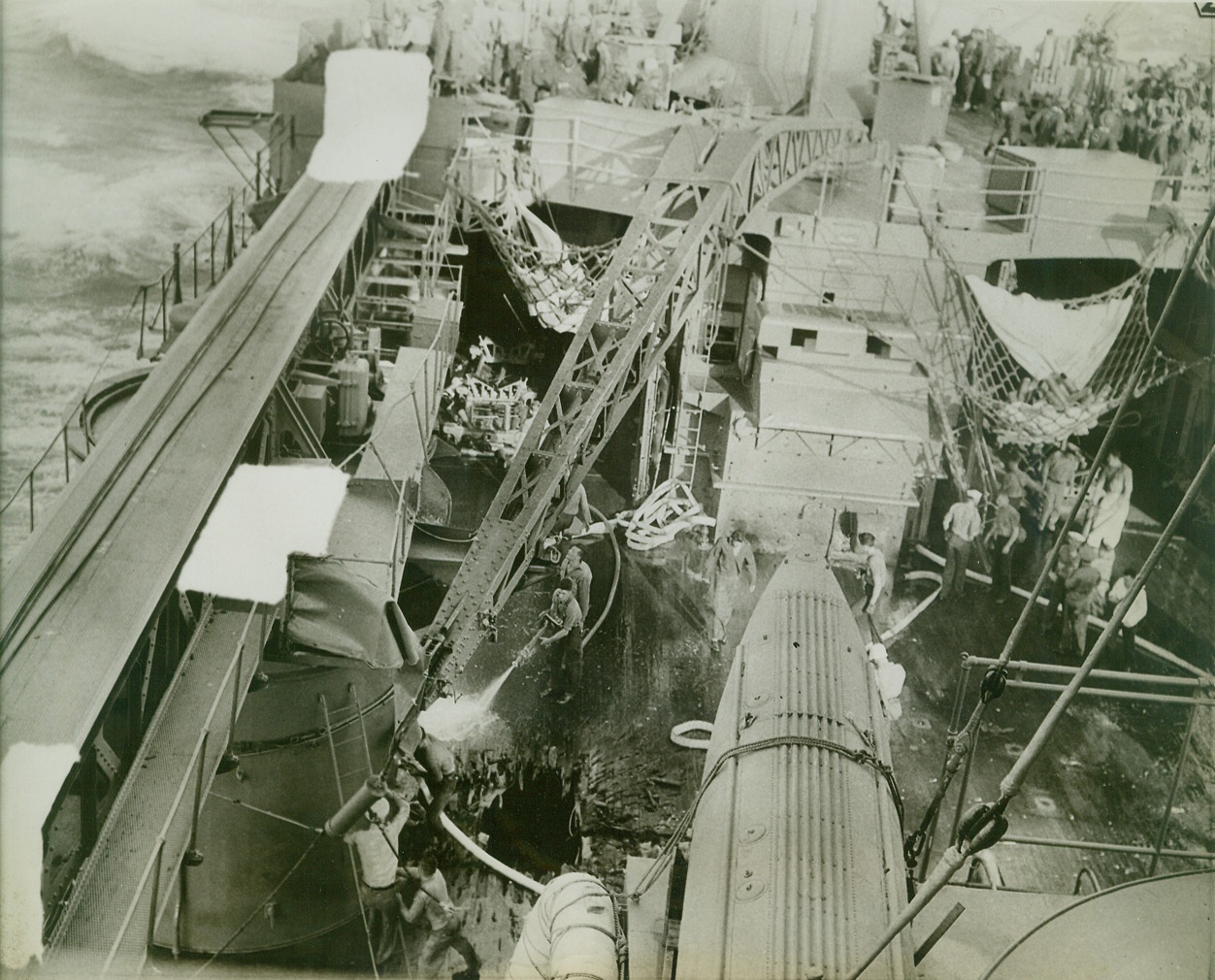
First Pictures Show Bomb Damage to U.S. in Jap Attack, 2/15/1942. San Francisco—In one of the first pictures to arrive in the United States following the Navy’s daring blasting of Japanese bases in the Pacific, bomb damage to one of the Pacific fleet’s units is shown here. A seller plays a stream of water from a hose on the hole in the deck as the damage control party swings into action to stop a fire from a Jap hit. Credit: ACME.;
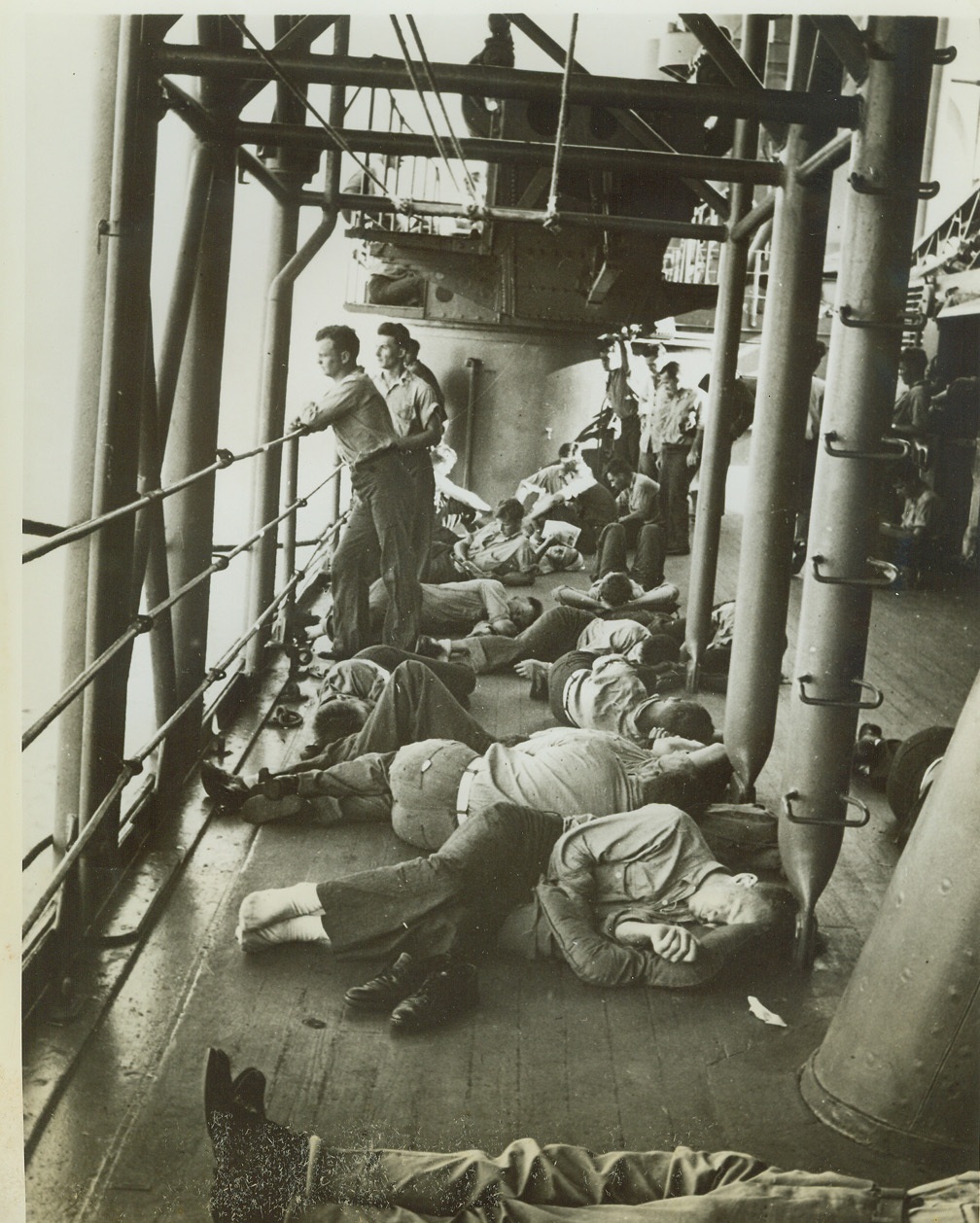
Sailors Sleep After Day of Battle, 2/18/1942. SOMEWHERE IN THE PACIFIC -- Sailors as they slept with heads pillowed on life jackets, on the deck of a unit of the U.S. Fleet, the day after the United States Navy had attacked the mandated Gilbert and Marshall Islands. Note another group of sailors standing watch as vessel traveled through sub-infested waters. Credit: (ACME);
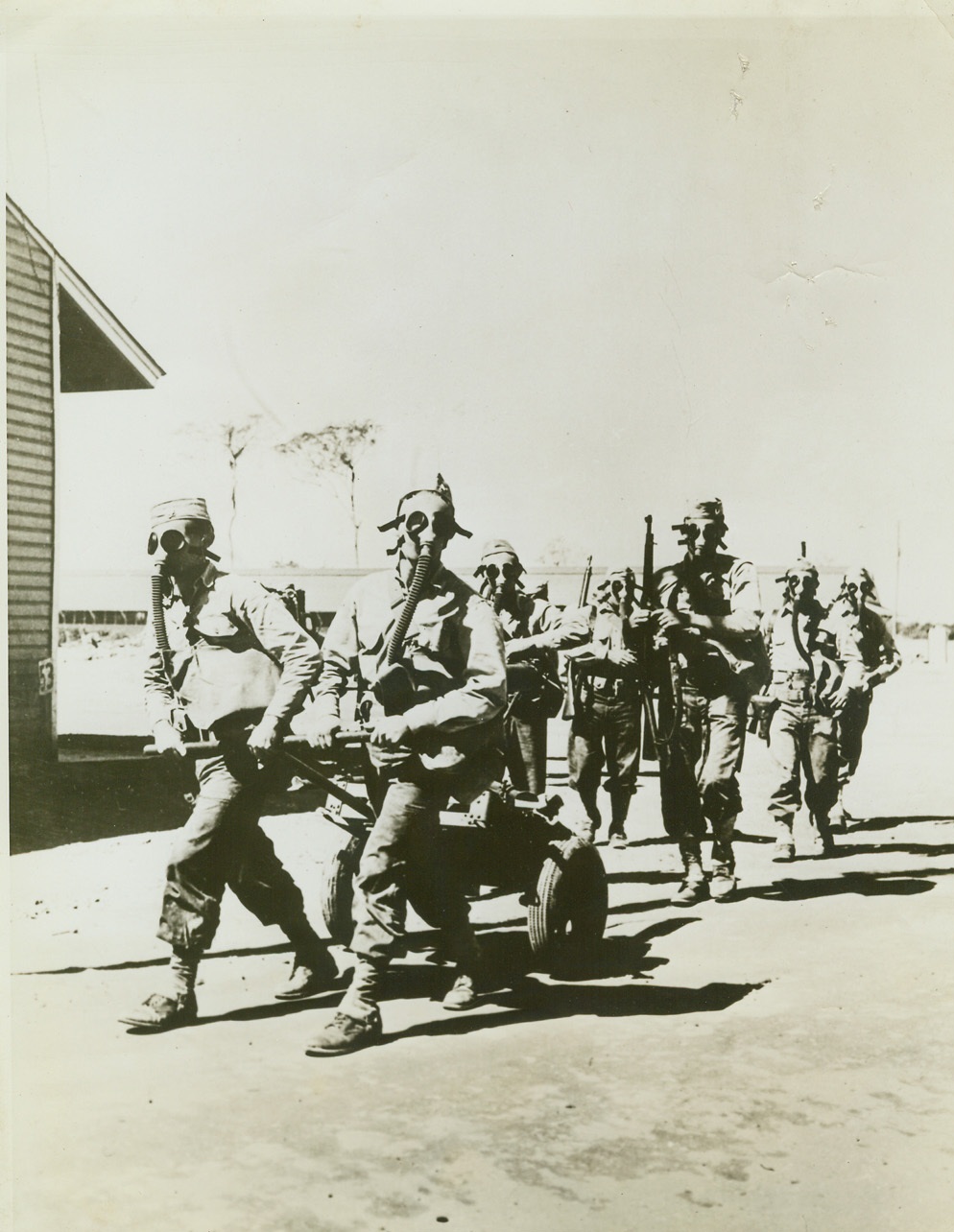
With U.S. Army in Trinidad, 2/27/1942. Trinidad—U.S. Army troops stationed in this West Indies base go through exercises with mounted machine guns while accustoming themselves to wearing their gas masks. Credit: U.S. Army Signal Corps from ACME.;
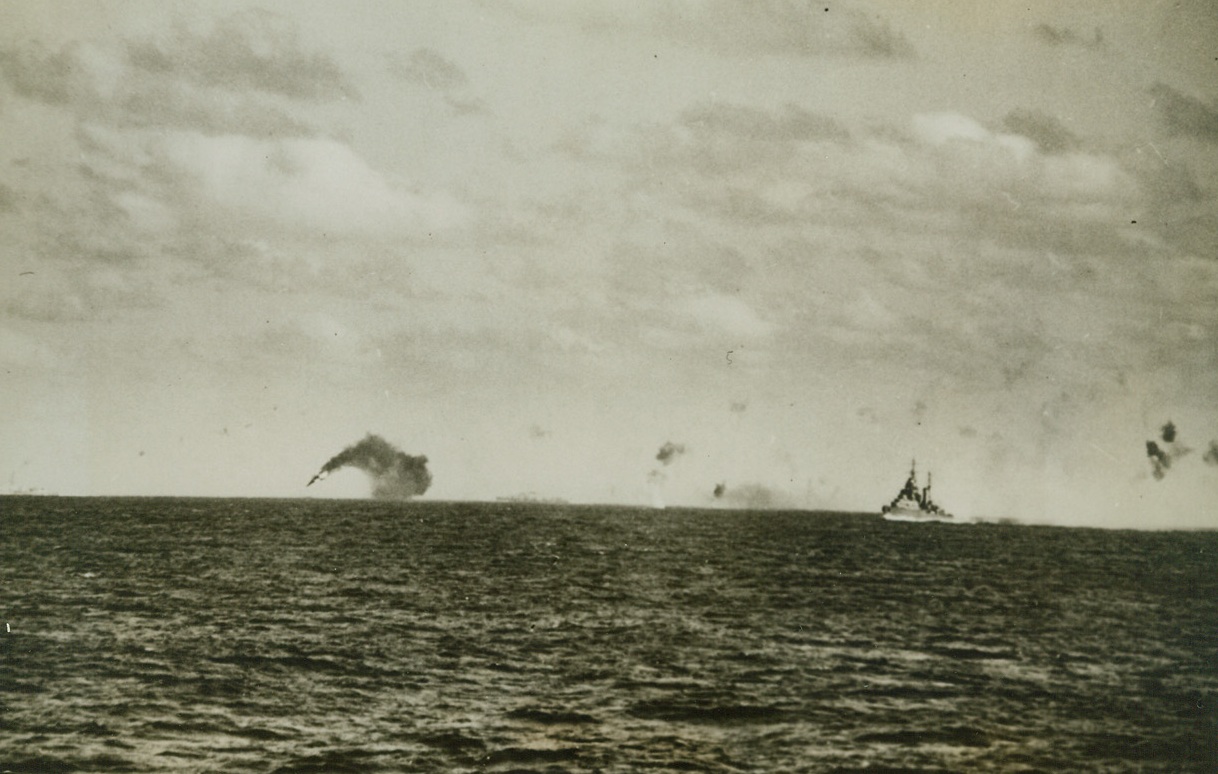
Italian Bomber Goes Down in Flames, 2/28/1942. Trailing dense black smoke, an Italian Savoia torpedo bomber plunges toward the surface of the Mediterranean, shot down during a 5-hour-long raid on a British convoy by Italian and German planes. The sky is pock-marked with puffs of smoke from the antiaircraft fire from the British escorting warships which ultimately drove off the attackers. Convoy and warships were undamaged.Credit: (ACME);
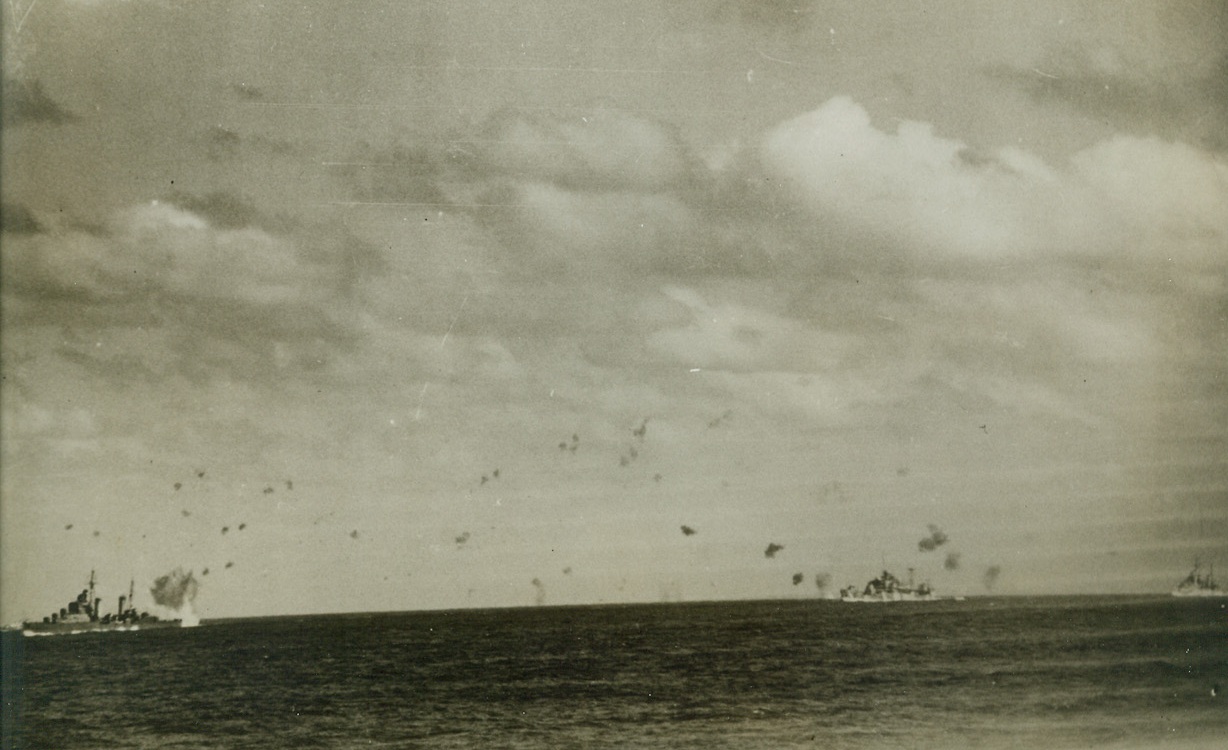
NEAR MISS IN AIR ATTACK ON BRITISH CONVOY, 2/28/1942. A bomb explodes dangerously near to the stern of a British destroyer (extreme left) escorting a convoy across the Mediterranean as a formation of over a hundred German and Italian planes blast away in a five-hour attack. A formidable barrage of anti-aircraft fire from the convoy’s escorting warships finally drove off the air attackers. One Italian torpedo bomber was shot down in flames. The convoy and its escort was undamaged. Credit: Acme;
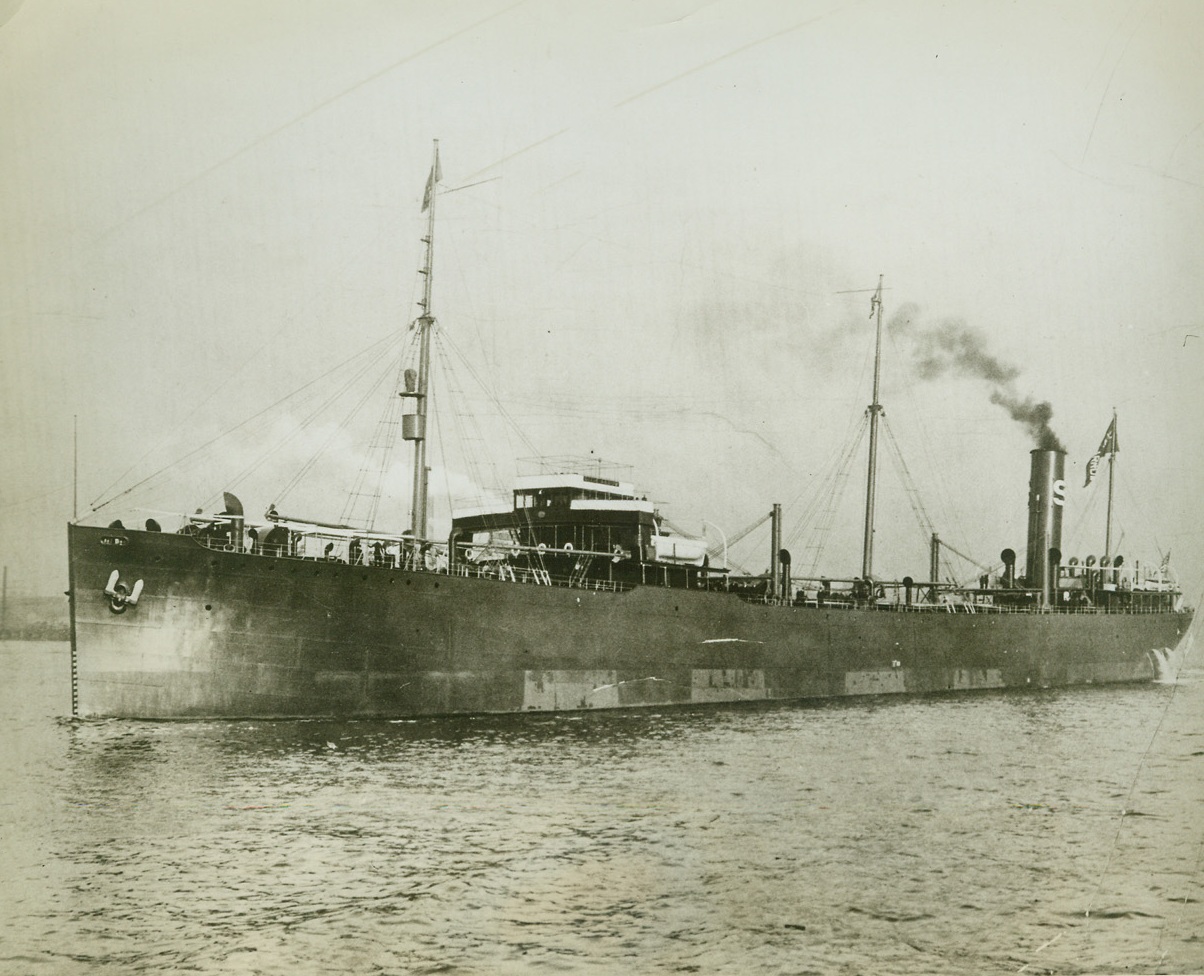
Sunk by Sub Off Jersey Coast, 2/6/1942. ATLANTIC CITY – The 8327-ton American tanker, India Arrow, which was torpedoed and sunk by a submarine Wednesday night off the New Jersey coast, with twenty-six members of the crew missing. Twelve survivors, including the captain, reached shore today. The India Arrow was the 18th ship attacked and the 17th ….the U-boat campaign off the ….;
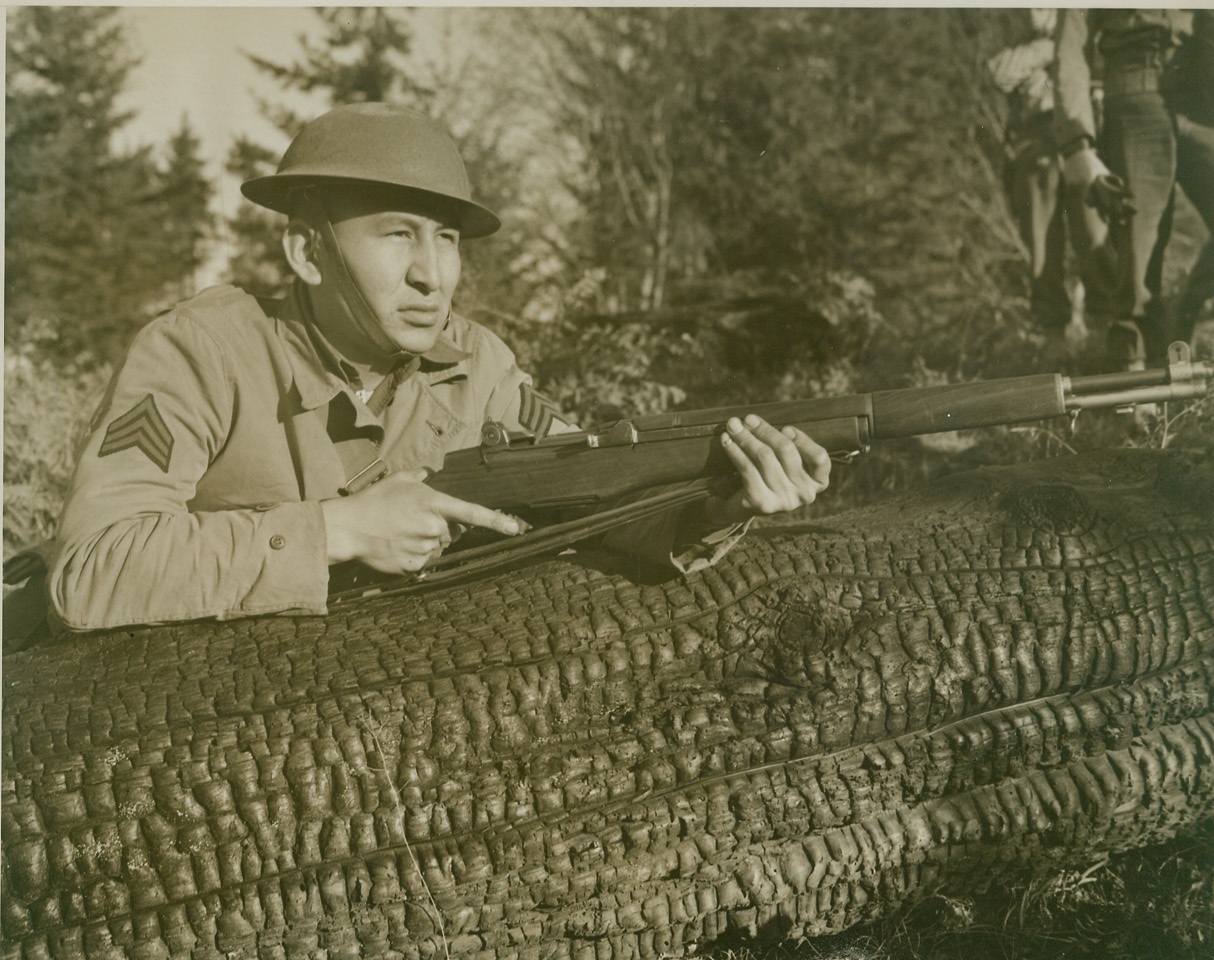
GOOD SCOUT, 2/7/1942. A Sioux Indian Scout of Uncle Sam’s Army looks out over the terrain “somewhere in the Pacific Northwest.” In this war as in World War I, the U.S. Army is using American Indians for scouting work. Credit: OWI Radiophoto from ACME;
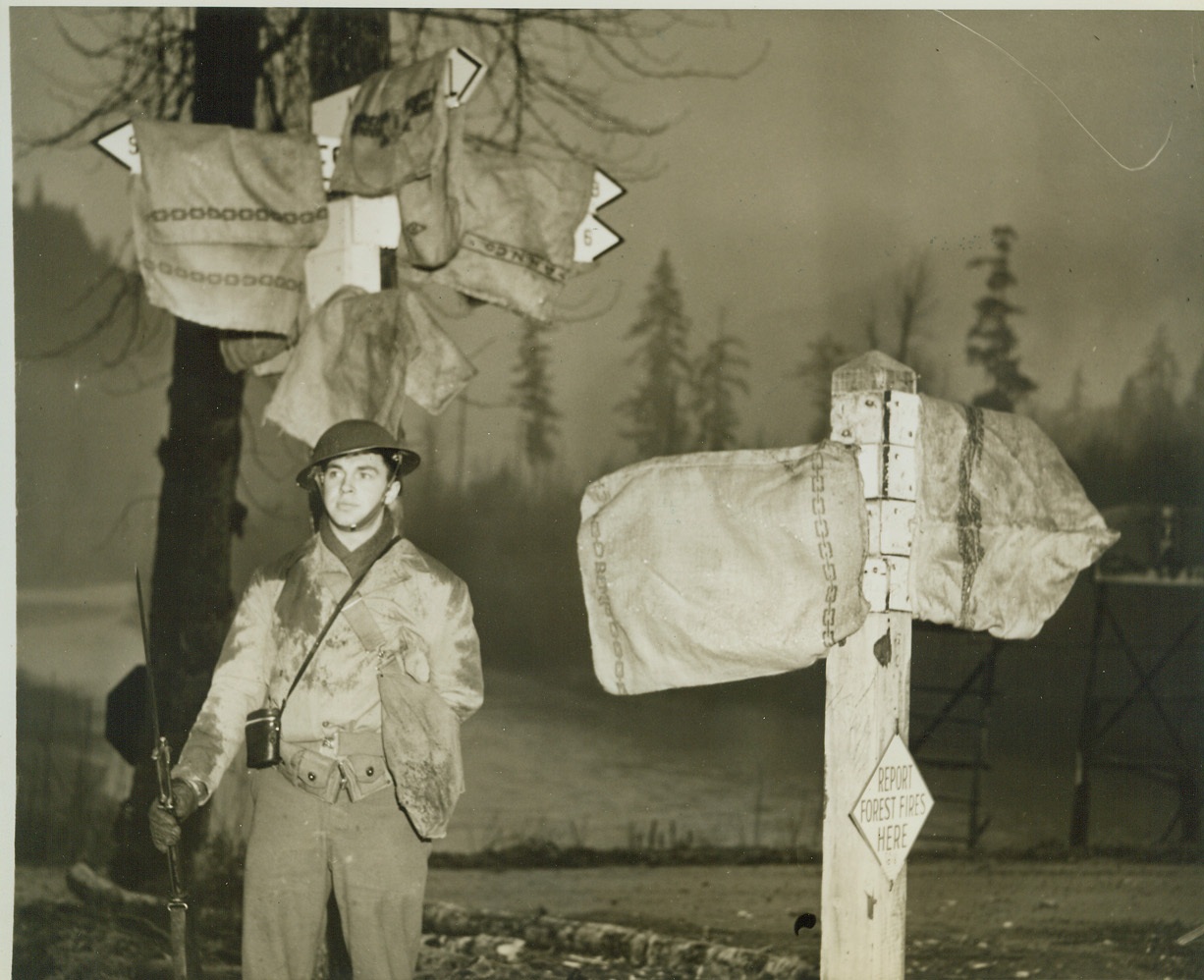
It’s _______ Miles to ________., 2/7/1942. One thing you can’t show in a photograph is the location of U.S. troops. That’s why these signposts are covered as a soldier stands sentry somewhere in the Pacific Northwest. As you can see from the signs, it’s several miles to some place or other. Anyway, it’s rainy there. Or was when the picture was taken. Credit: ACME.;
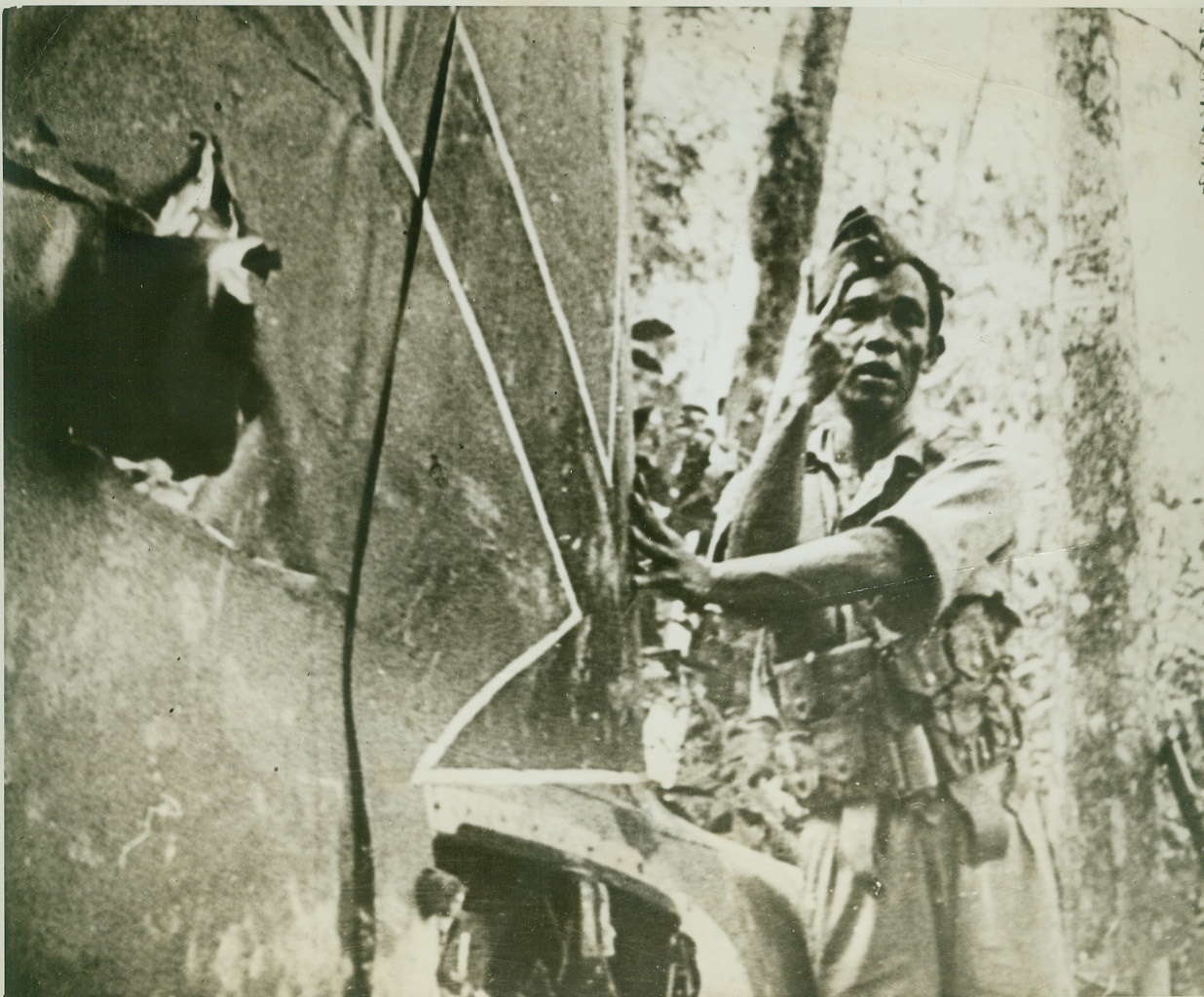
TAIL OF WRECKED JAPANESE AIRCRAFT, 2/8/1942. MALAYA – Tail of Japanese plane, shot down in Malaya by British anti-aircraft, shows the red arrow marking of Nippon aircraft. The rest of the aircraft, which received a direct hit, was scattered over a mountainside and the body of the pilot found a half-mile away, with his parachute unopened. (Passed by Censors.) Credit: ACME;
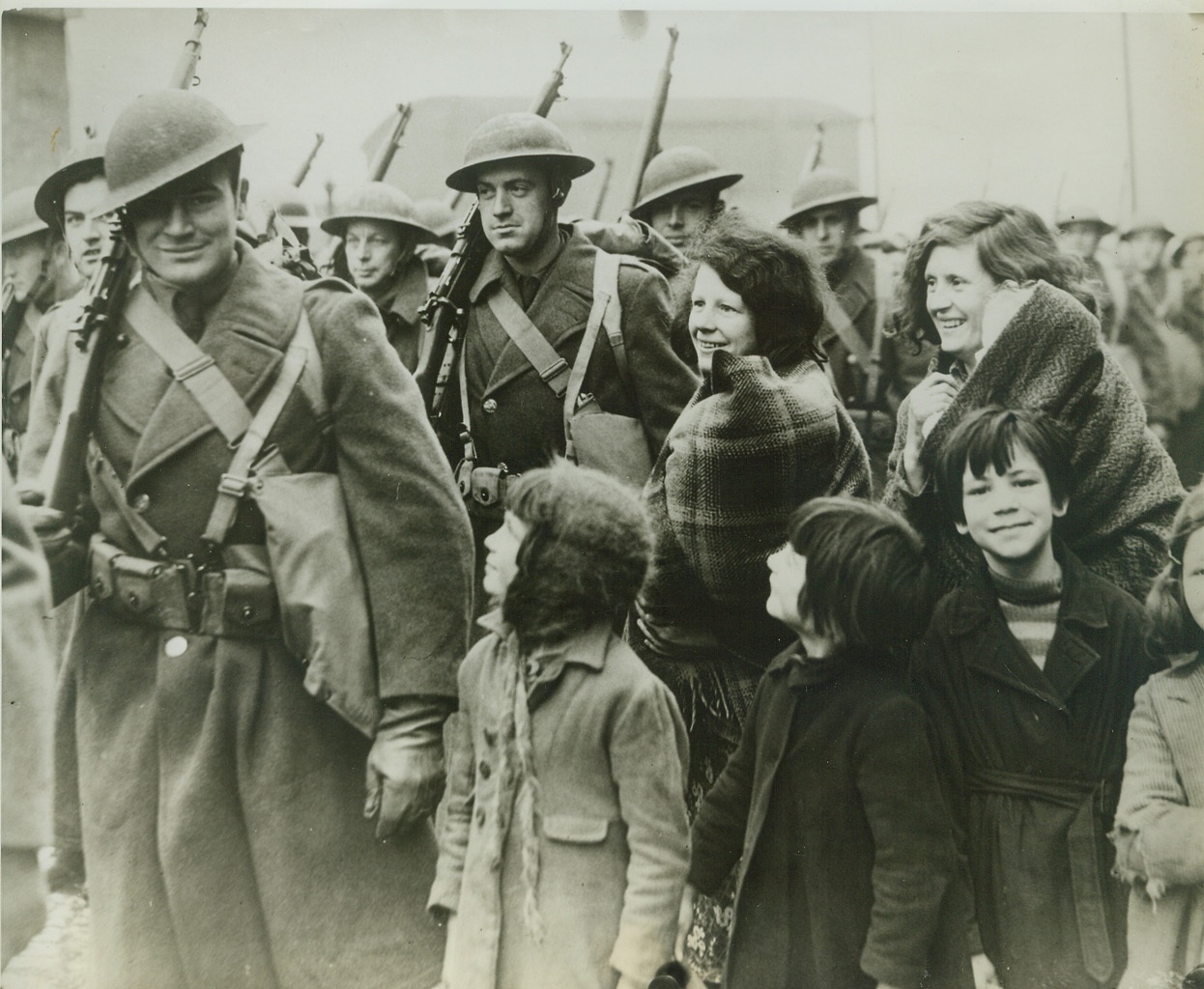
Irish Women and Children Greet American Troops, 2/8/1942. AN IRISH PORT -- Women and children in a port "somewhere in Northern Ireland" as they greeted troops of the American Expeditionary Force, on its arrival. Credit: (ACME);
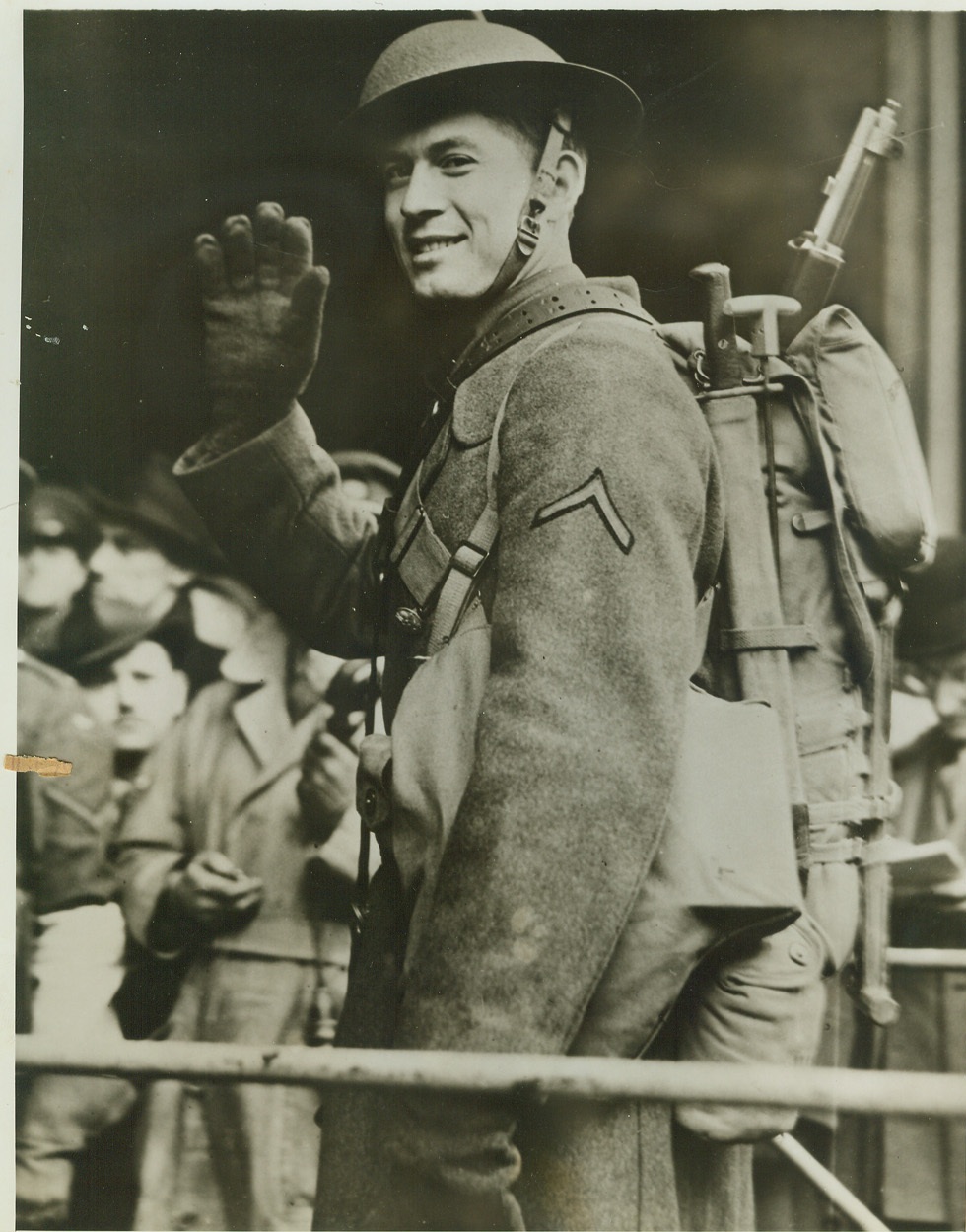
First American Soldier Lands in Ireland, 2/8/1942. NORTHERN IRELAND -- Pvt. Milburn Henke, of Hutchinson, Minn., waves as he walks ashore in Northern Ireland, first American soldier to set foot on British Island soil during World War II. He was selected at random from the ranks by the commanding officer of the expeditionary force, Maj. Gen. Russell P. Hartle. Credit: (ACME);
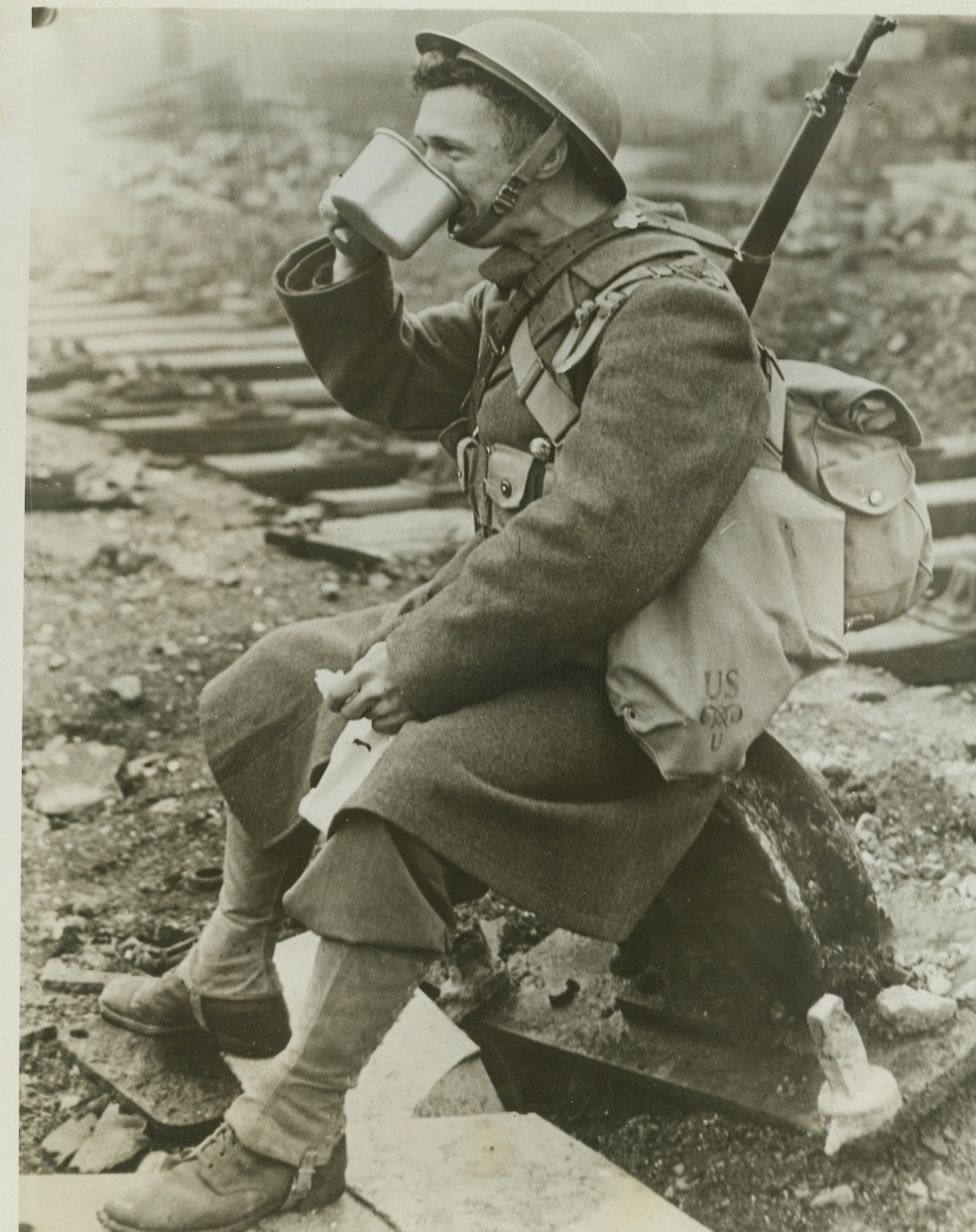
American Soldier Enjoys Mug of Tea in Ireland, 2/8/1942. A NORTHERN IRISH PORT -- An American soldier, member of the American Expeditionary Force, as he enjoyed a mug of tea on a dockside, in "A Northern Irish Port." Credit: (ACME);
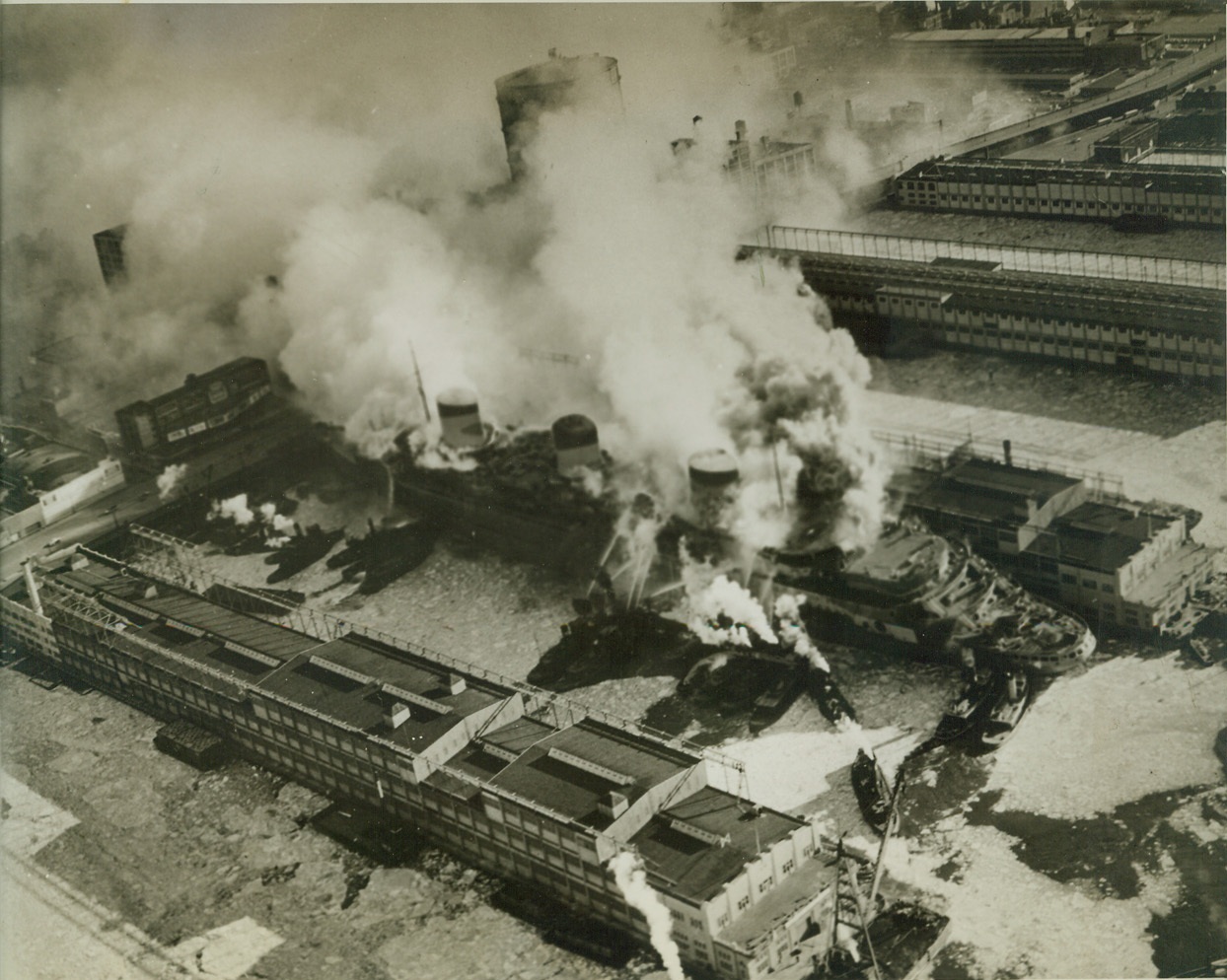
U.S.S. LAFAYETTE BURNS AT PIER, 2/9/1942. NEW YORK, N.Y.—Smoke billowing up both fore and aft from flames which gutted her upper decks, the former French luxury liner Normandie-now the U.S.S. Lafayette-burns with loss estimated unofficially at five million dollars at her Hudson River Pier. At lest one man, a workman trapped aboard the ship, was dead and at least 75 others injured. Photo made from a U.S. Army plane, shows fireboats playing streams of icy water on the ship, while city firemen on the dock attacked the flames on the starboard side. Credit: OWI Radiophoto from U.S. Army by 2nd Air Base Squadron, ACME;
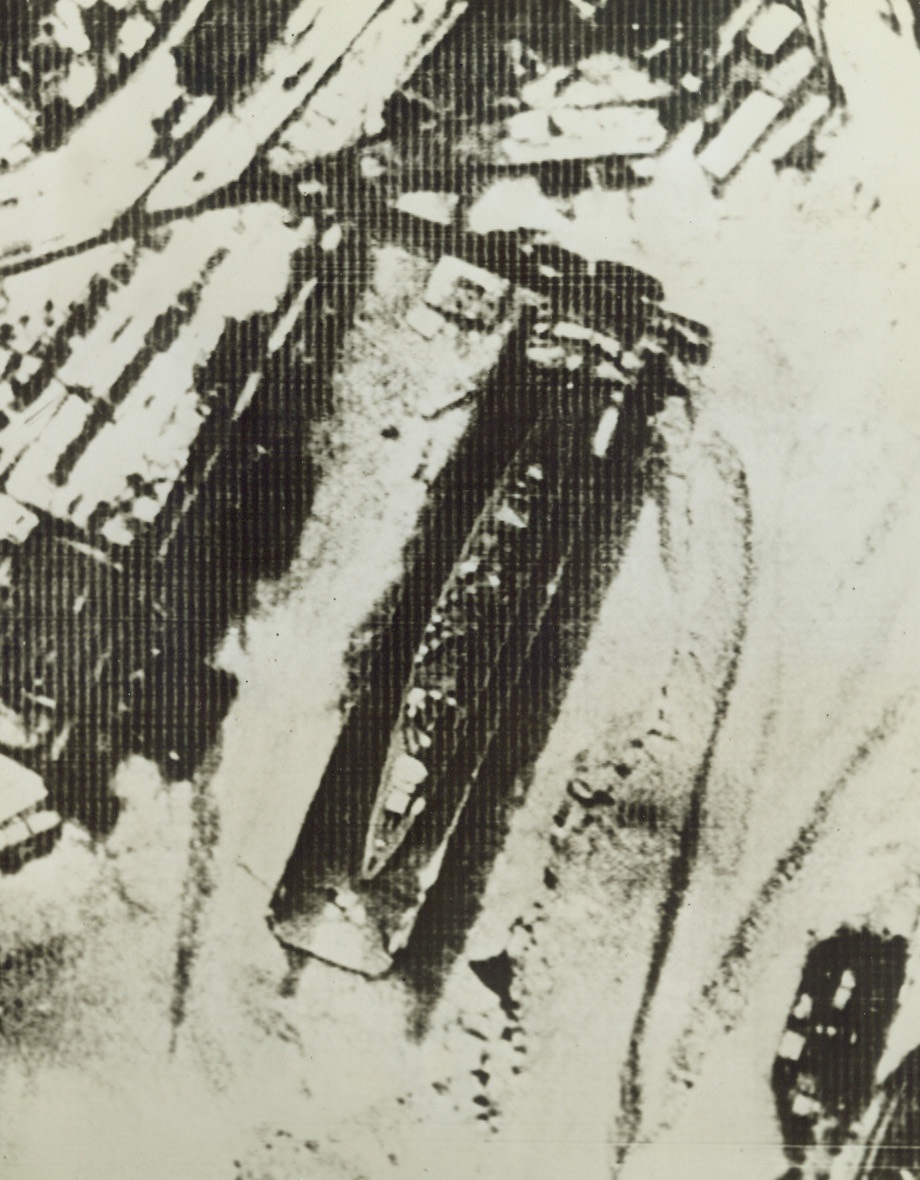
GNEISNAU SPOTTED AT KIEL, 2/27/1942. KIEL, GERMANY—Docked at the Kiel Naval base after its daring flight through the English Channel from Brest, the German battleship Gneisnau is spotted by an R.A.F. plane in this aerial photograph. British say the ship and her sister ship the Scharnhorst, were put out of commission for some time to come in the running battle through the Channel.Credit: Acme Cablephoto;
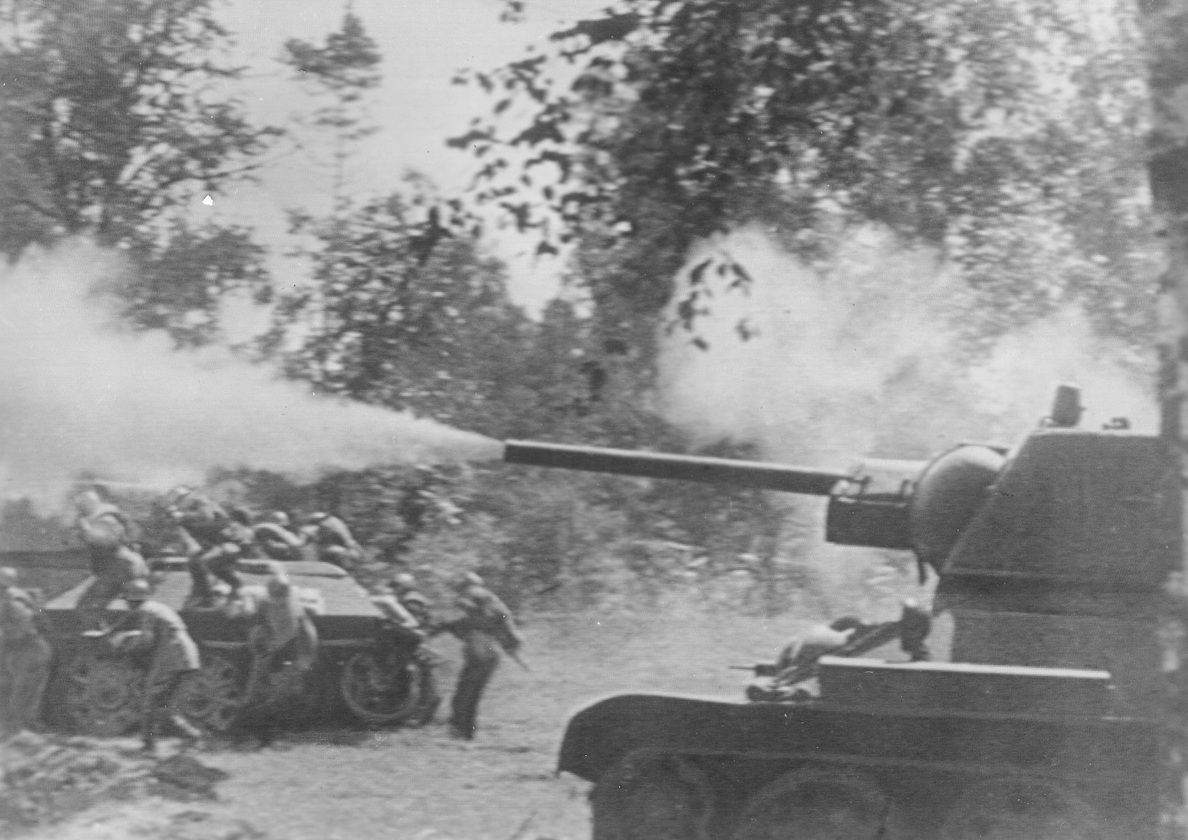
“March of Time”, 2/11/1942. Russian tank, (R), fires point blank at enemy while from a companion tank (L), on which they had ridden into mouth of enemy guns, brave Russians jump to the attack.Credit: ACME Telephoto;
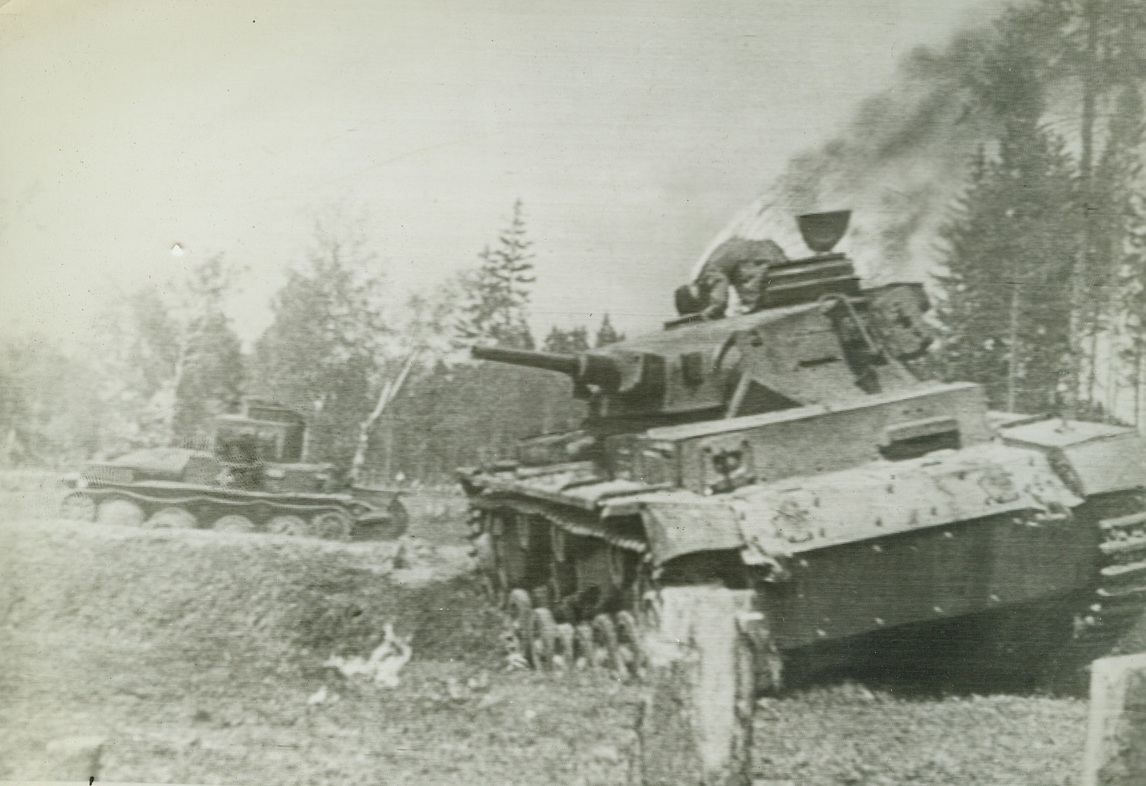
“March of Time”, 2/11/1942. From film record of one day of war on Russian fronts, filmed by 160 Russian cameramen, 39 of whom died in action, came this battlefield scene as a German tankman turns attempting escape from tank at right; another filled with dead at the left.Credit: ACME Telephoto;
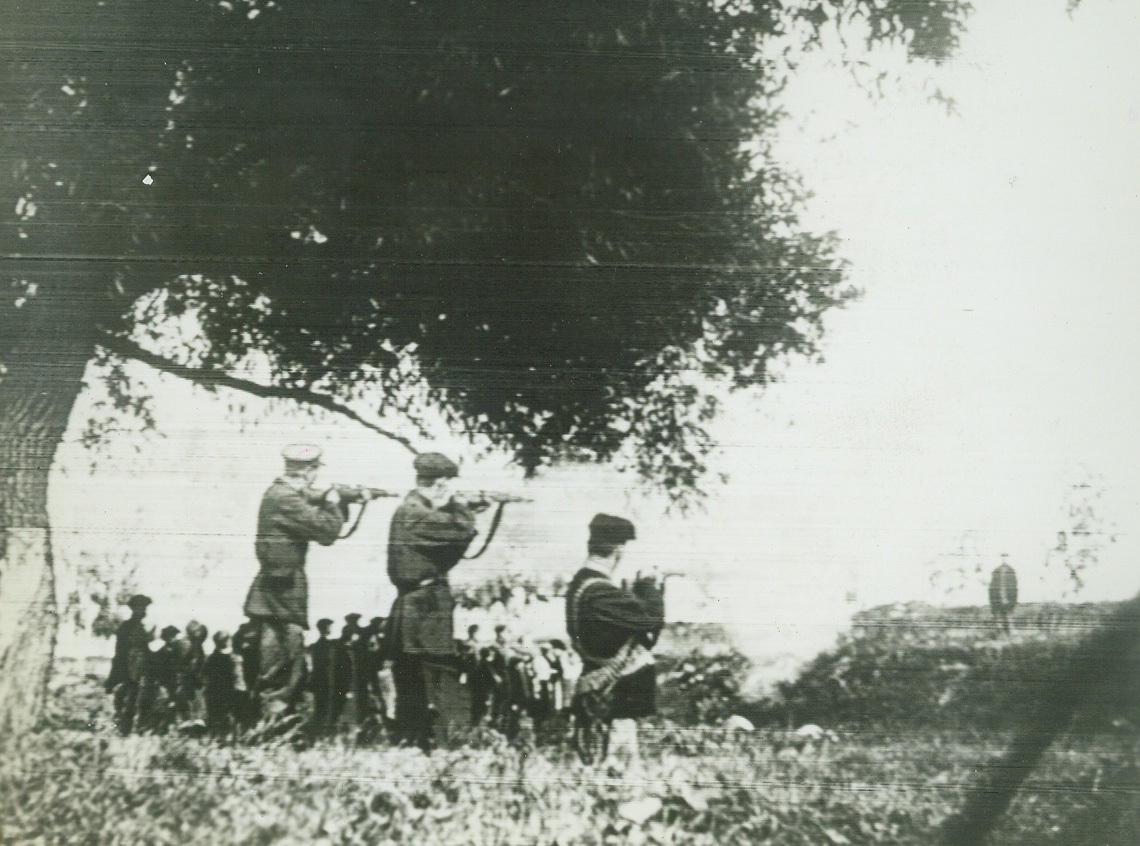
“March of Time”, 2/11/1942. (No. 3 in series) The village turns out to watch the execution of the fifth columnists whose perfidy cost lives of his fellow-villagers in the action in No.1.Credit: ACME Telephoto;
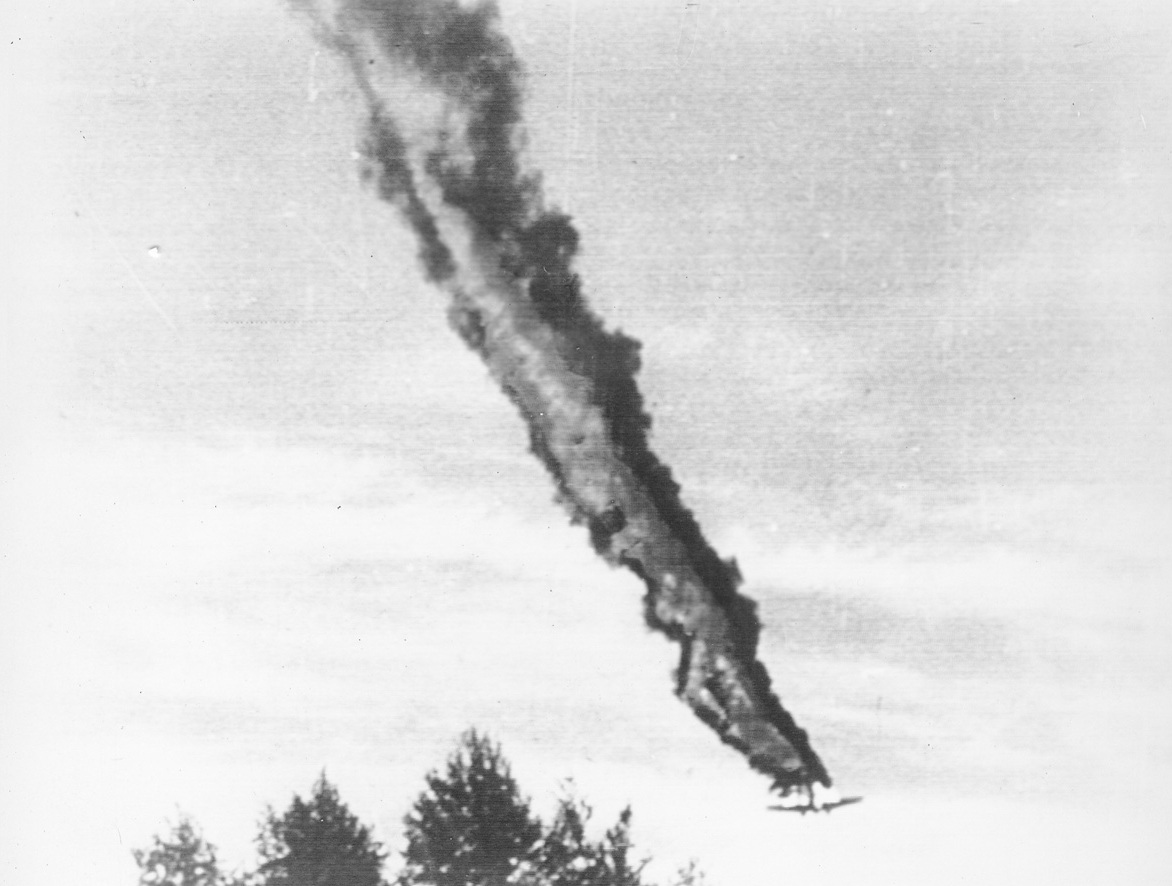
‘March of Time”, 2/11/1942.
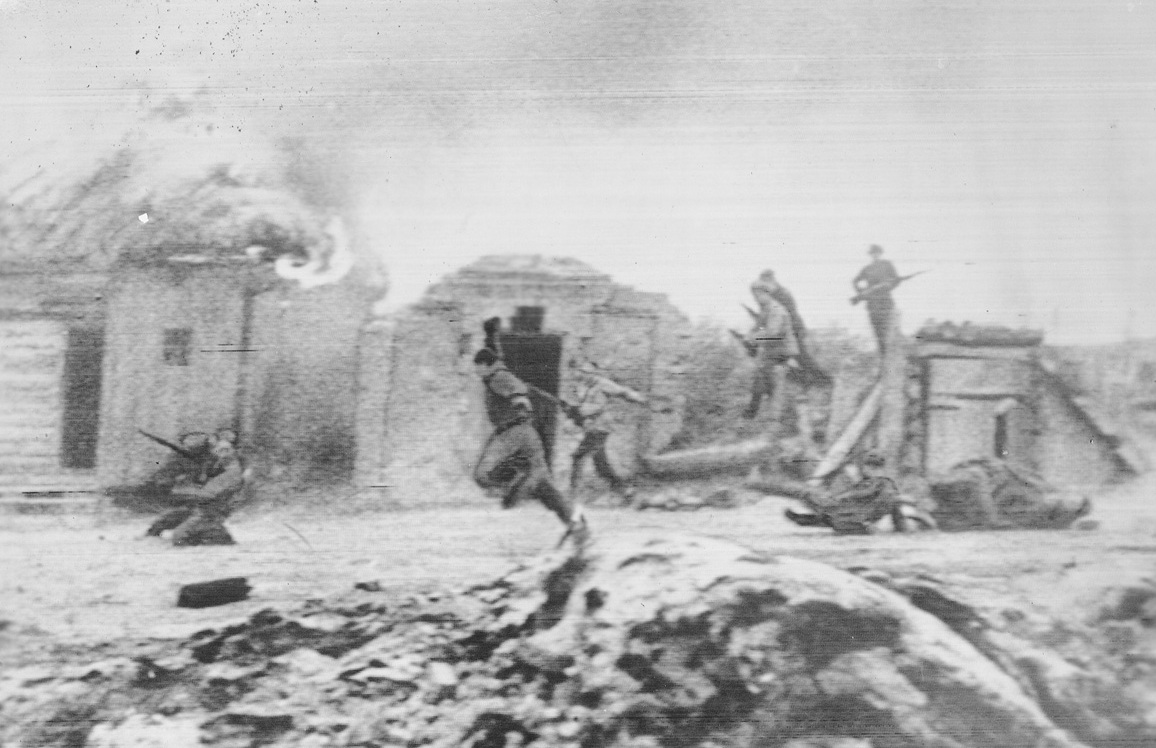
‘March of Time”, 2/11/1942. No. 1 in this series. Russian guerillas, surprising a Nazi-Hungarian Brigade in this Russian village, cut the invaders to pieces. But a treacherous informer cost the lives of 12 brave men. Here cottages burn, men fall, during height of fighting.Credit: ACME telephoto;
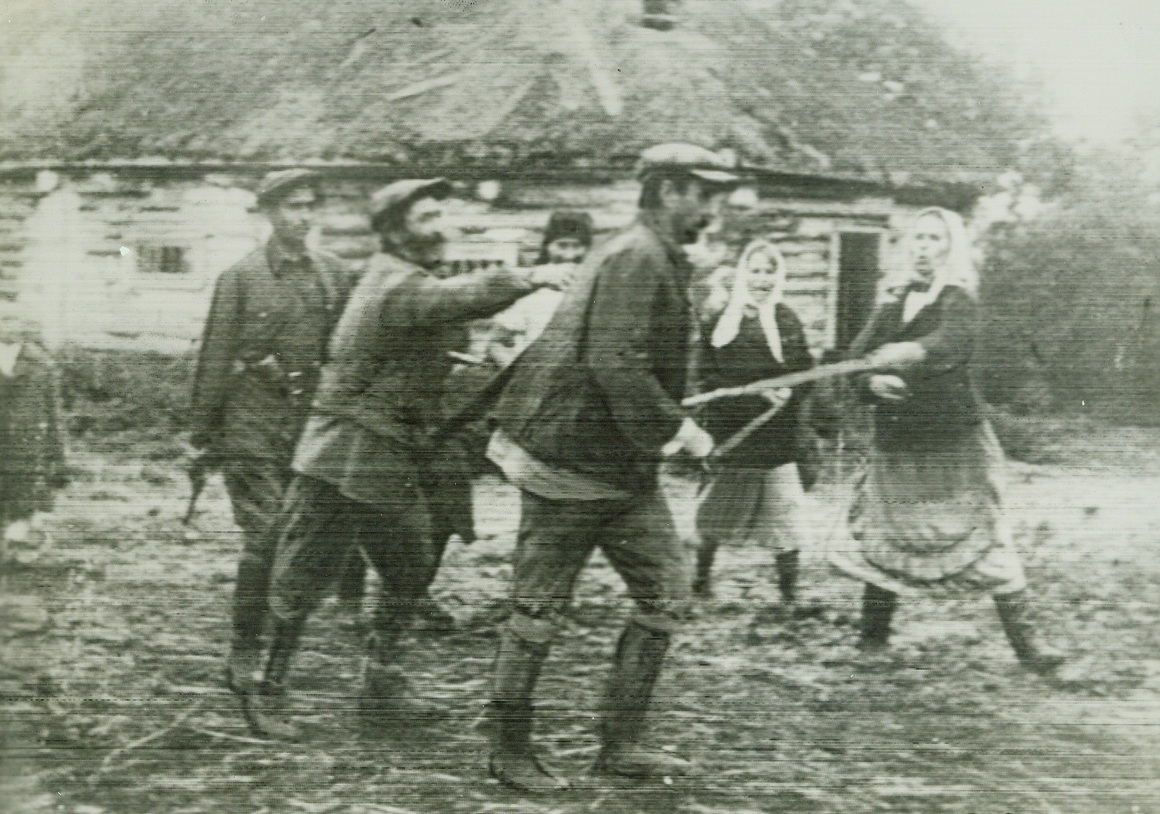
“March of Time”, 2/11/1942. No. 2 in series. Here the fifth columnist, foreground in cap, is led out after seizure by the men he betrayed. Women perhaps even the wives of the dead men, belabor the traitor with brooms and sticks.Credit: ACME telephoto;
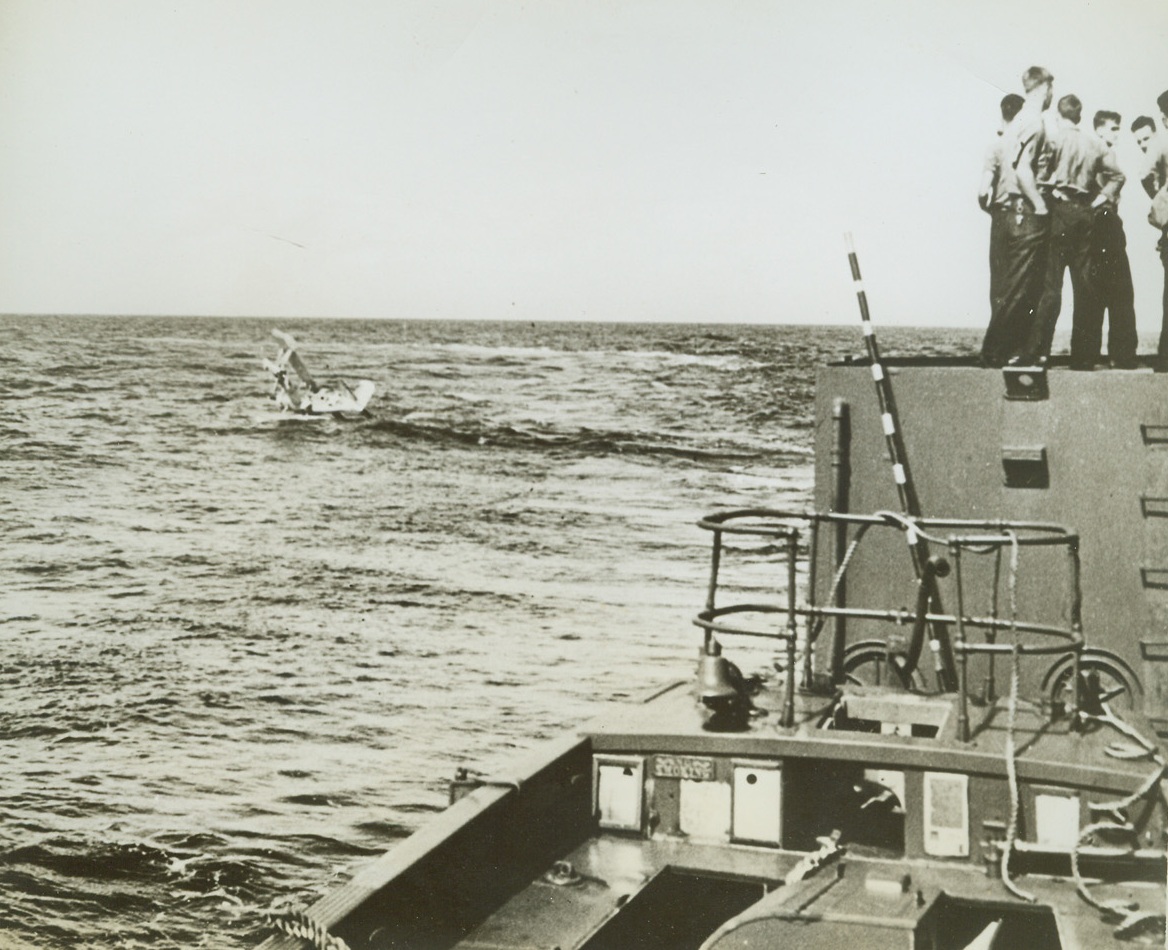
U.S. plane crashes during attack on Jap islands somewhere in the Pacific, 2/18/1942. SOMEWHERE IN THE PACIFIC – a plane from a U.S. cruiser, as it crashed in a forced landing after it had suffered damage in the U.S. Navy attack on the Japanese mandated Gilbert and Marshall islands. Credit line (ACME);
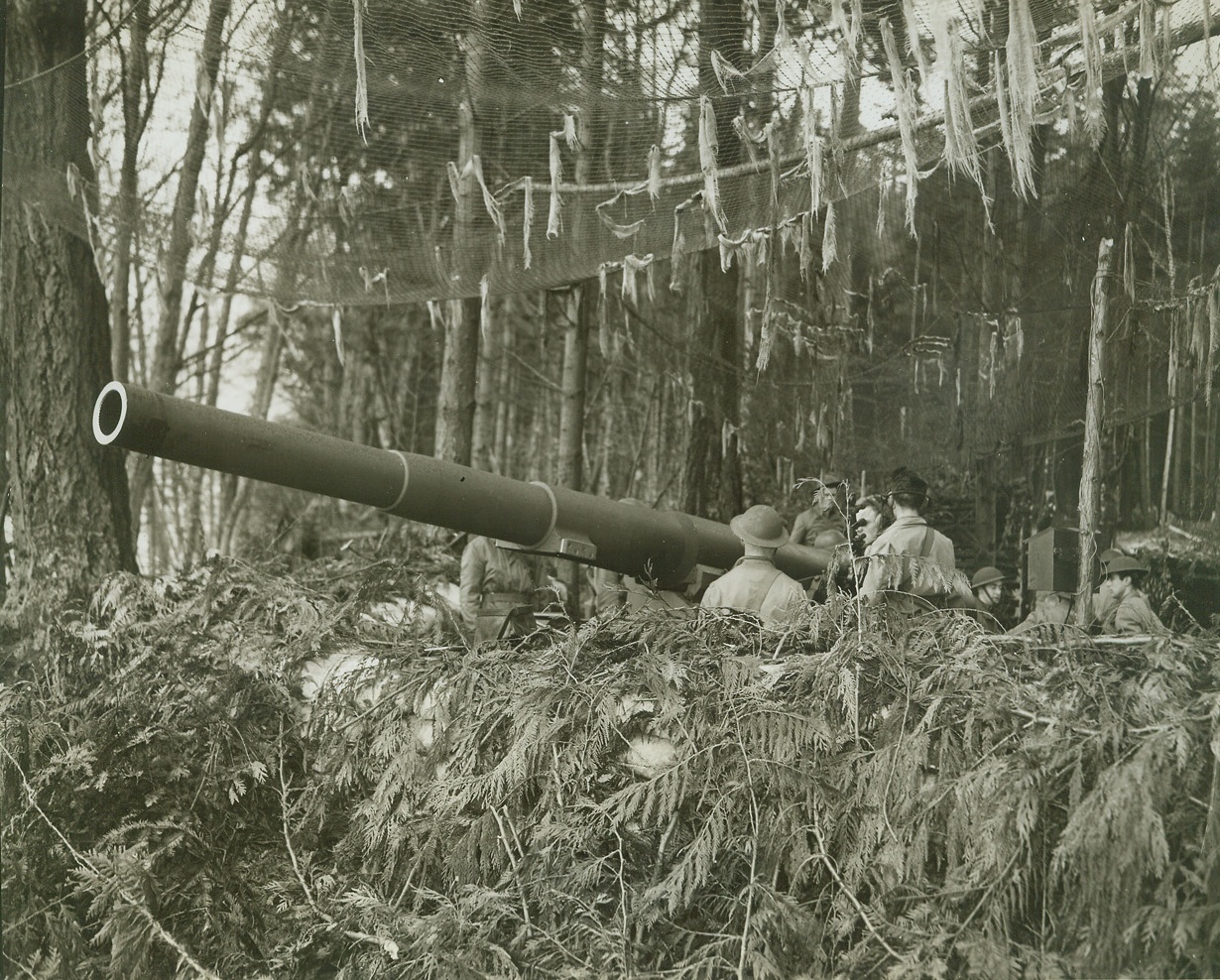
Seen Any “Visitors”?, 2/7/1942. One of the Army’s heavy mobile guns points out to sea somewhere in the Pacific Northwest from its camouflaged hiding place in the forest. Credit line (ACME);
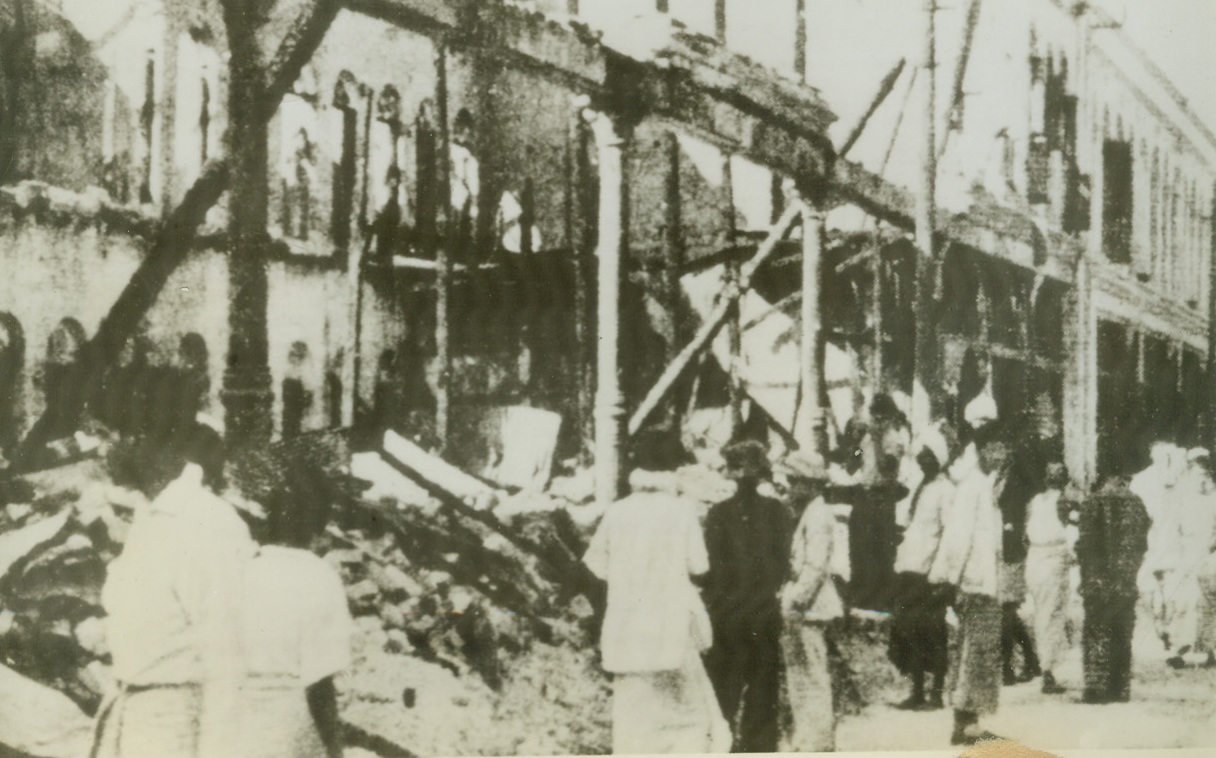
Ravaged Rangoon, 2/7/1942. Rangoon – Here’s one of the first photos to come from Burma, showing a Rangoon street ruined by raiding Jap bombers. Yesterday morning fliers of the U.S. volunteer group of Jap raiders in a daylight engagement after the city had been pounded by waves of bombers all night. Photo was flashed to New York from London today by radio. Credit ACME radiophoto;
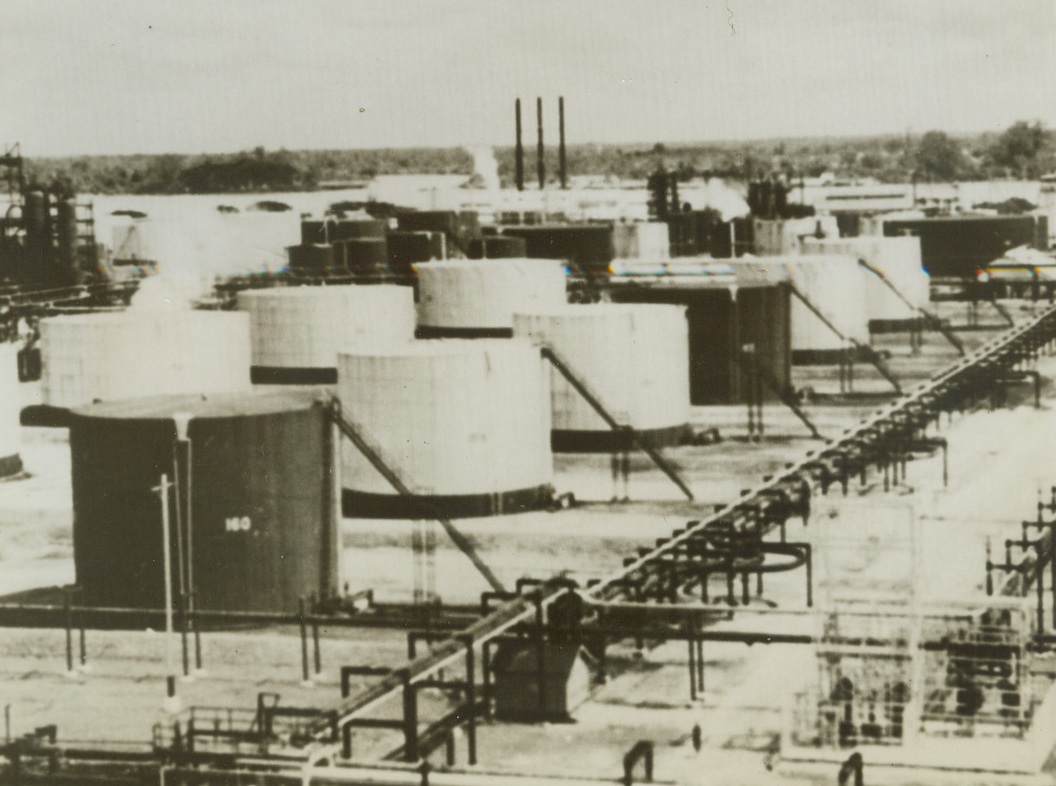
In Oil-Refining Area Threatened by Japanese, 2/15/1942. Netherlands East Indies.—Japanese troops poured ashore in Southern Sumatra today for a land drive on Palembang (60 miles inland), center of what probably is the richest single oil field between the Persian Gulf and the United States, but they were too late to save their vanguard of several hundred parachutists, who were all but wiped out yesterday, when they swooped down on Palembang oil refineries and other vital points. Here is a general view of the giant standard oil company’s plant in Palembang. Credit line (from March of Time’s far East command from ACME);
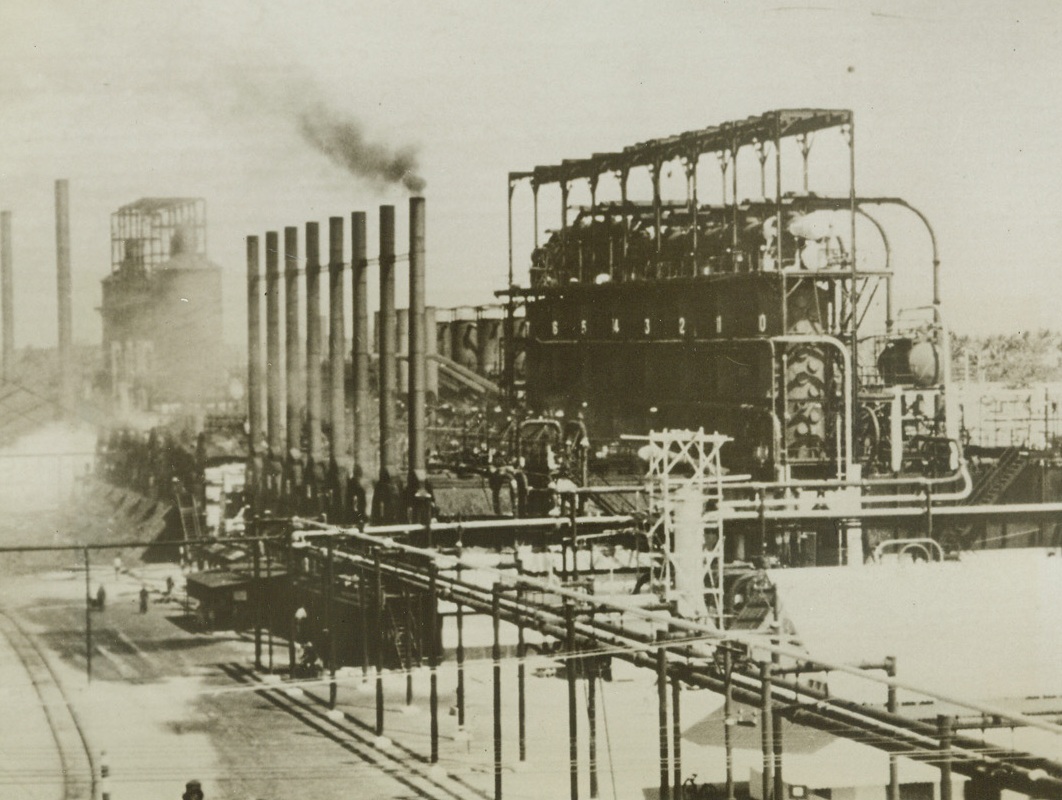
Japs Want This, 2/15/1942. Netherlands East Indies – View of the huge standard oil company’s plant in the oil refining area of Palembang in Sumatra, which is threatened by the landing of Jap troops in Southern Sumatra today for a land drive on Pelembang, 60 miles inland. It was assumed that the Netherlanders would not hesitate to apply their scorched-Earth policy to the refineries and oil fields, representing an investment of hundreds of millions of dollars, if plant actually became endangered by the invaders. Credit line (from March of Time’s far East command from ACME)Netherlands East Indies – View of the huge standard oil company’s plant in the oil refining area of Palembang in Sumatra, which is threatened by the landing of Jap troops in Southern Sumatra today for a land drive on Pelembang, 60 miles inland. It was assumed that the Netherlanders would not hesitate to apply their scorched-Earth policy to the refineries and oil fields, representing an investment of hundreds of millions of dollars, if plant actually became endangered by the invaders. Credit line (from March of Time’s far East command from ACME);
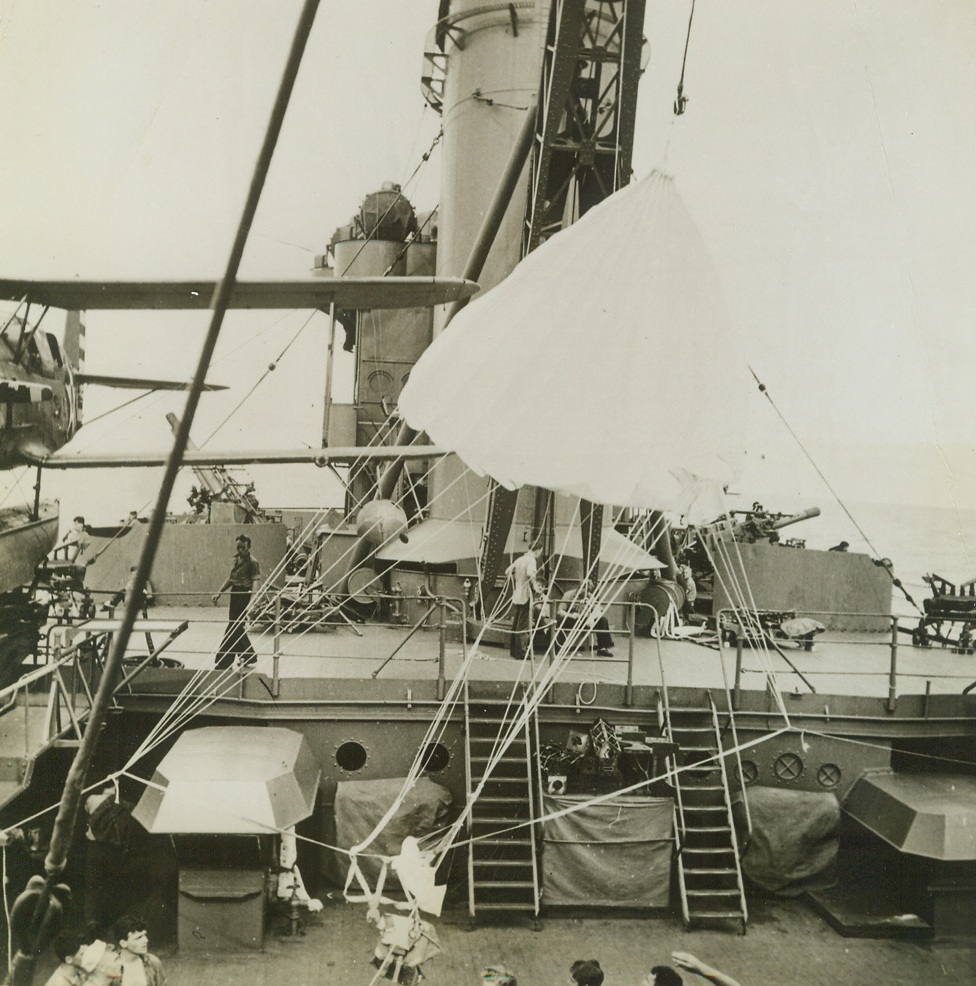
Lost U.S. Plane is Found – (#4), 2/18/1942. Somewhere in the Pacific – When patrol planes took off from U.S. cruisers during the United States Navy attack on the Japanese mandated Gilbert and Marshall Islands, they took off on dangerous missions, for after bombing their objective, they had to find their cruiser again before they ran out of gas. While they still had ten gallons left and if they were lost, they were forced to land on the sea and wait for rescue, so that they would have enough gas to taxi to a ship. Here, the Parachute of a pilot who had been lost for 14 hours, is shown as it hung to dry after his rescue by a cruiser. Credit line (ACME);
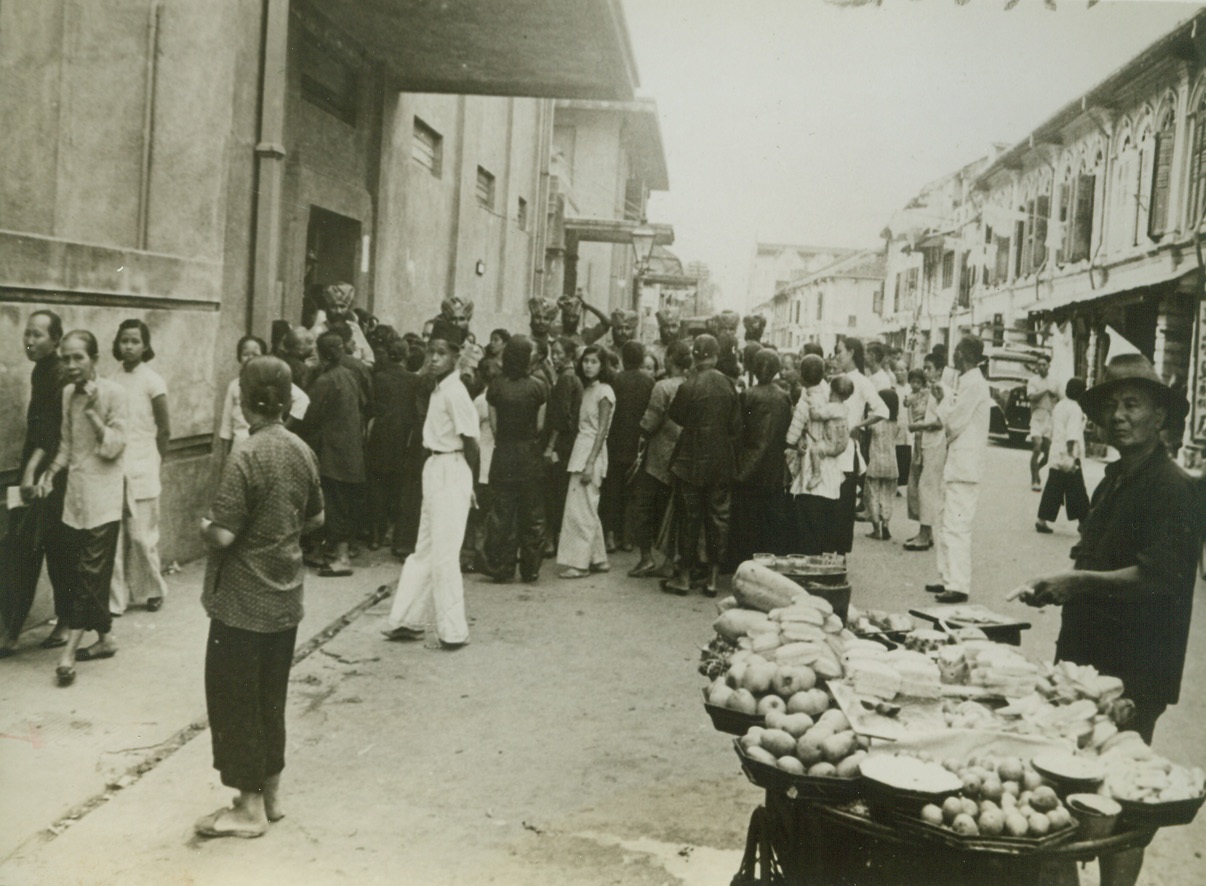
Security Registration in Singapore, 2/6/1942. Singapore – For a long time the people of Singapore have recognized the Jap threat to that great naval base. Here, weeks before the start of the siege of Singapore, residents of the city’s Chinese quarter are shown crowding into a building for security registration. A Chinese hawker peddles Malayan fruits in the street. Credit line (ACME);
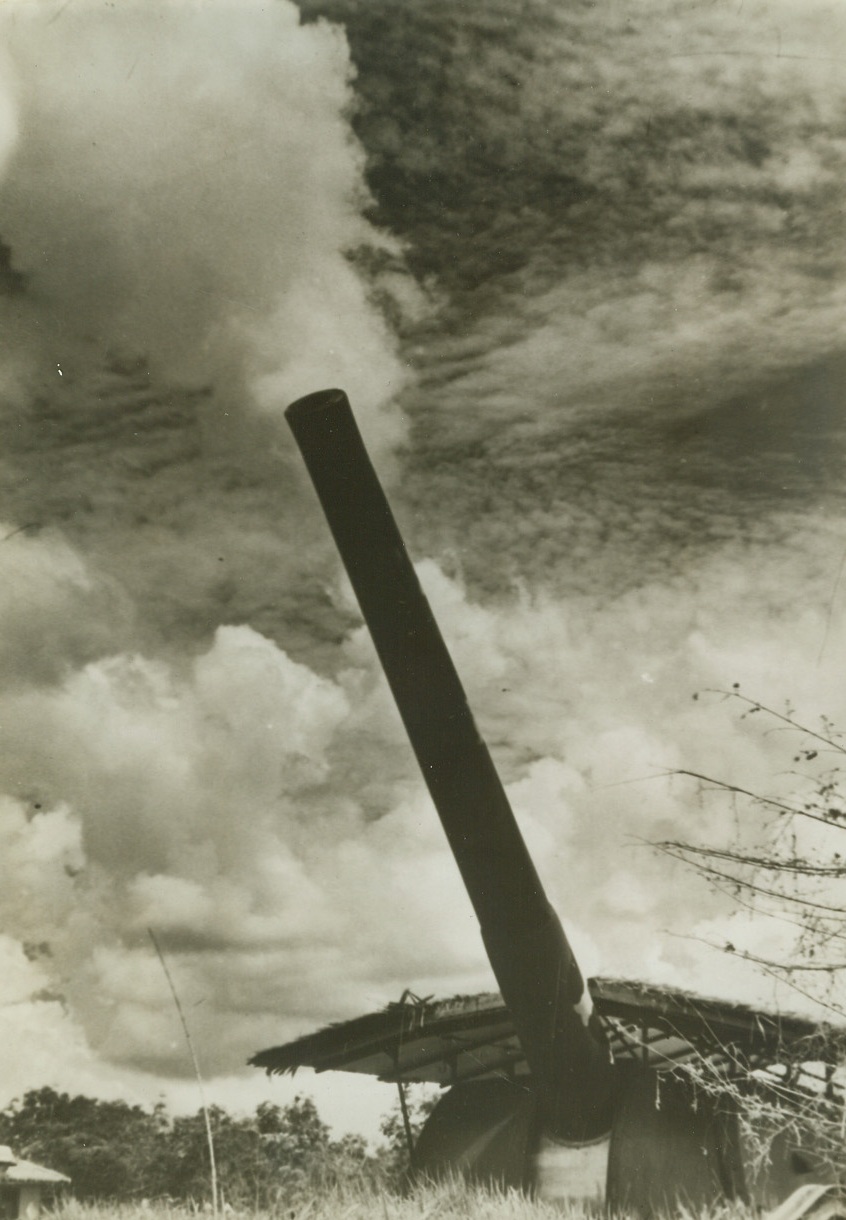
Singapore’s Big Guns Thunder, 2/5/1942. Singapore – This huge gun is typical of those which ring Singapore island strategically and which are endlessly bombarding enemy transport columns and concentrations on the Malay mainland, as British forces make a last stand on the besieged island. These guns today blasted into silence Japanese field guns which, in new emplacements had peppered the North shore. Credit line (ACME);
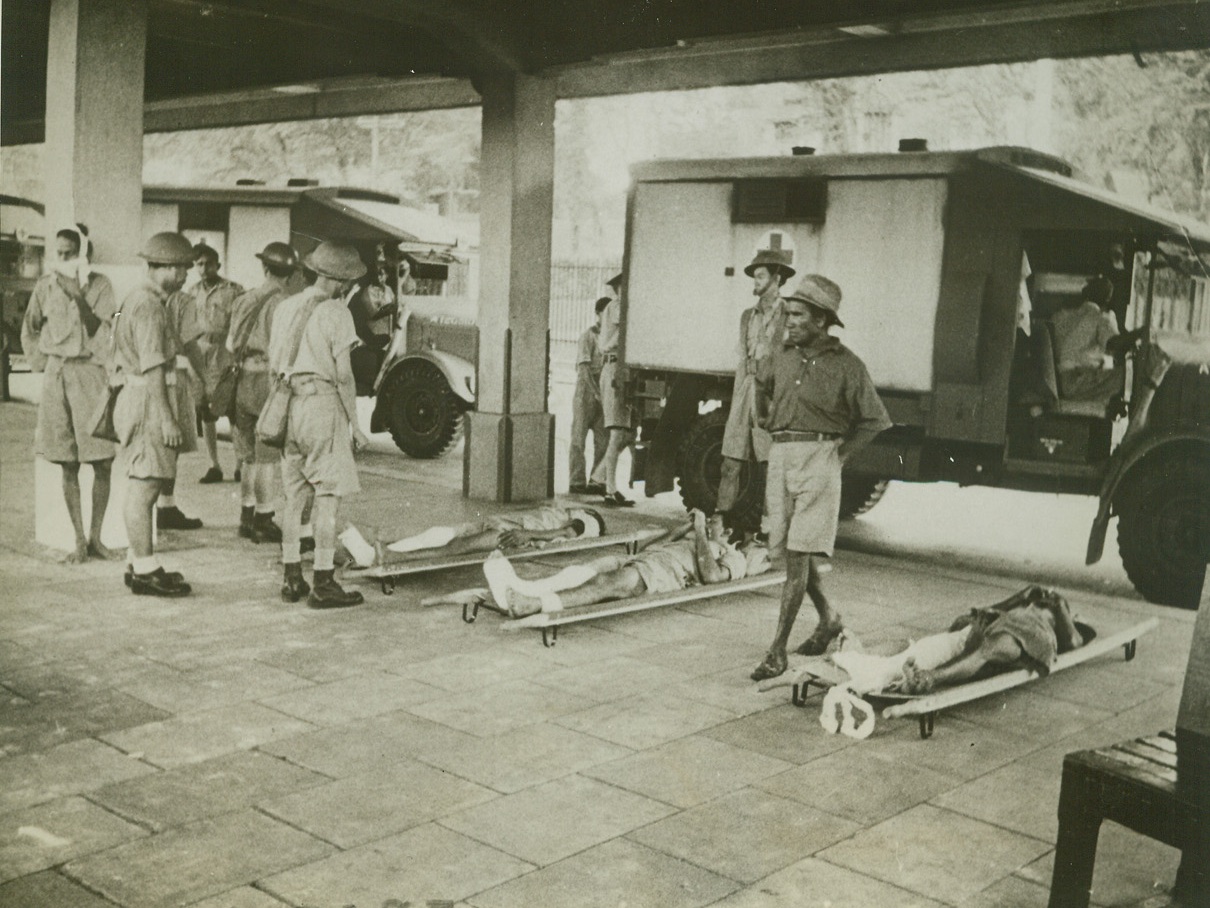
Malayan Chinese Aid British Wounded, 2/11/1942. Malaya – Chinese stretcher bearers have put wounded British soldiers down outside a Malayan station, while they wait for loaded ambulances to move on. Other ambulances are coming up and the Chinese watch their patients while they wait. Credit line (ACME);
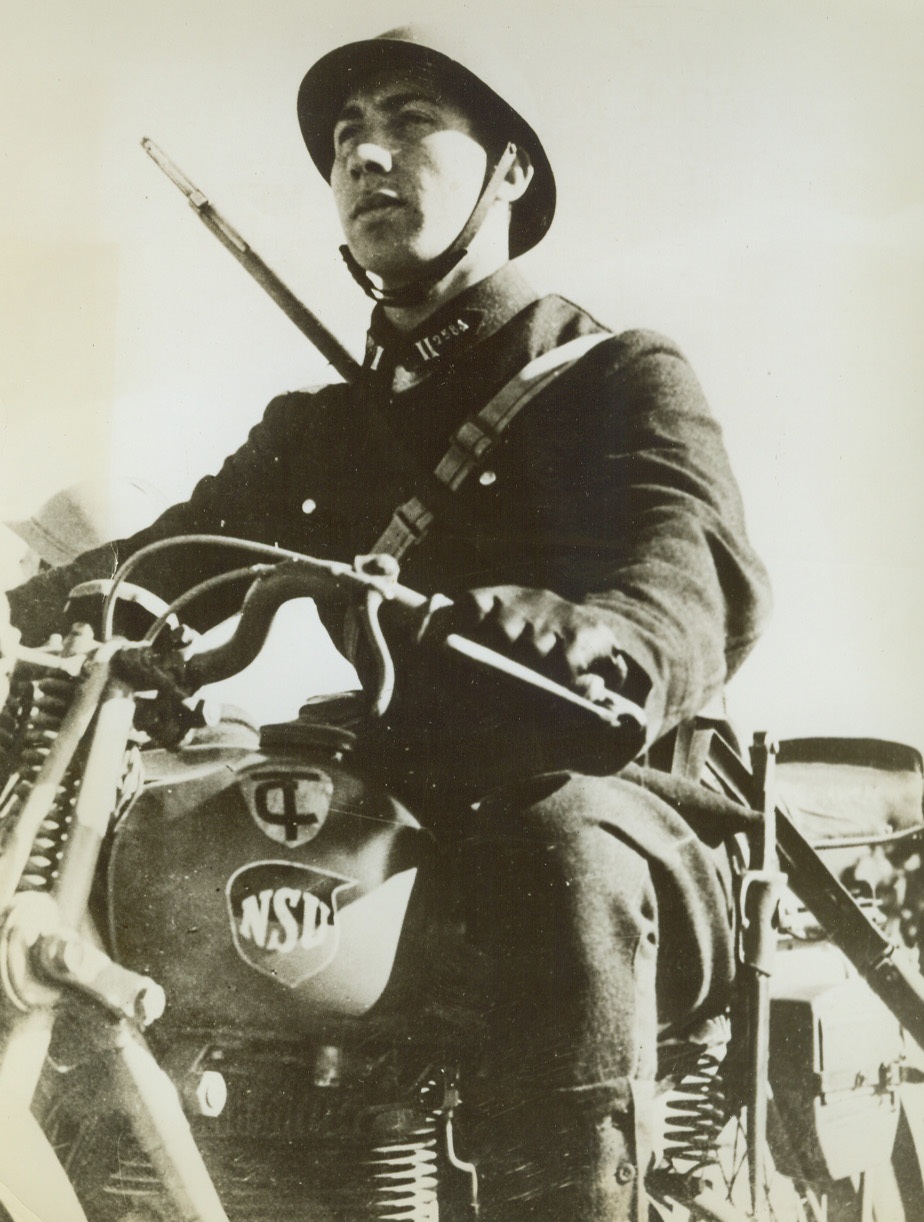
Turkey’s Army Prepares for Emergency, 2/2/1942. Turkey - - Alive to the dancers surrounding it, the stubbornly neutral country of Turkey is busy training its eligible youth for military service in case of emergency brought about by an invasion by a warring nation or the meeting of enemy nations on its lands. Photo shows a Turkish officer cadet in training with a motorcycle. Passed by Turkish and British censors. Credit line (ACME);
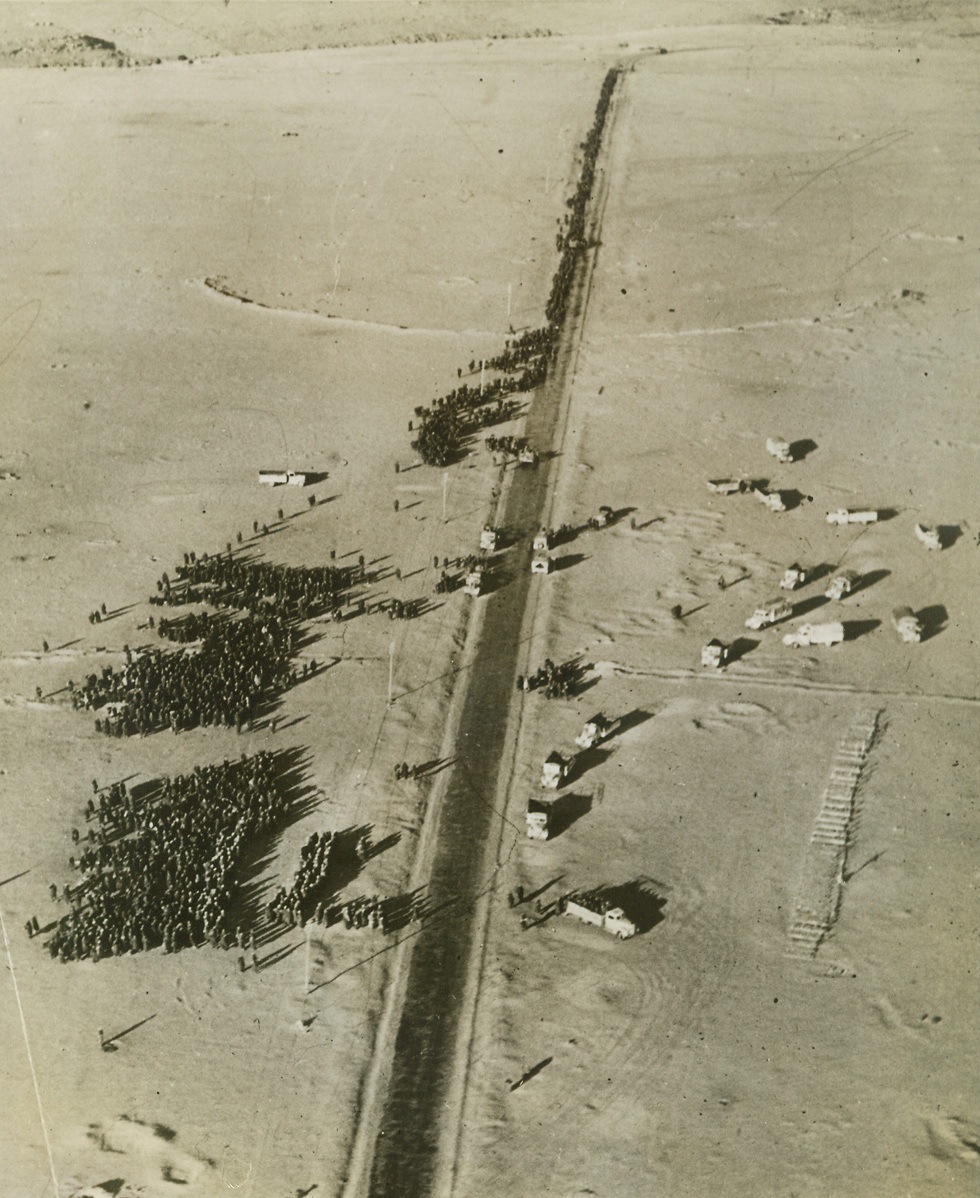
Oft-Repeated Scene in Desert, 2/2/1942. Bardia, Libya – Overtaken by mechanized South African troops in the Western Desert, German and Italian defenders of Bardia are herded together for transportation to a prison camp. It was the second time the Allies had captured the Libyan city, having been driven out after their first desert offensive. Credit line (ACME);
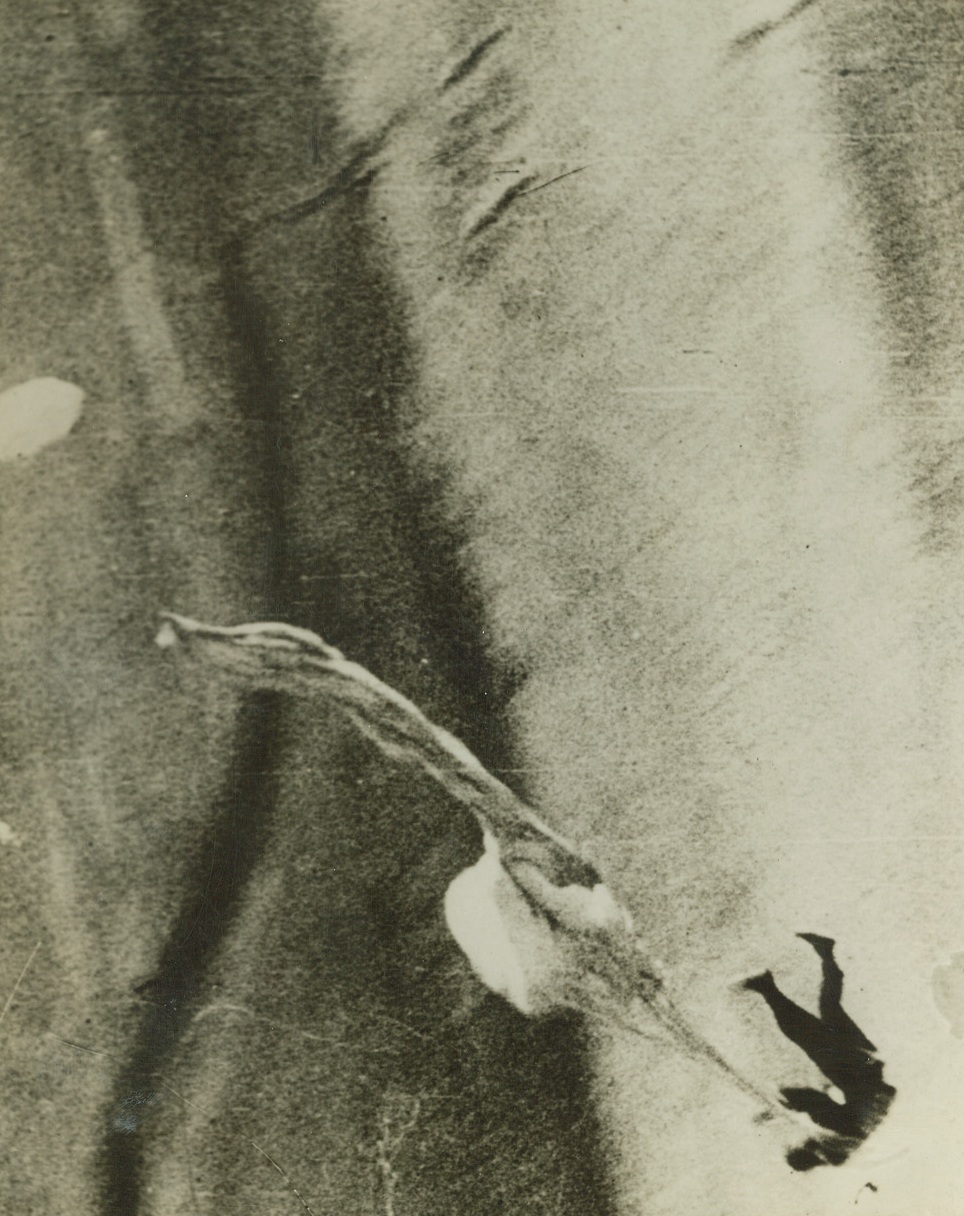
Another Soviet “First”—Parachute Nurses, 2/28/1942. Soviet Union—Here’s the latest development in nursing by the intrepid nurses of the Red Army—“paranurses.” Carrying medical supplies, the Russian nurses land in the front line zones where their services are most urgently needed. Passed by censors. Credit: ACME.;
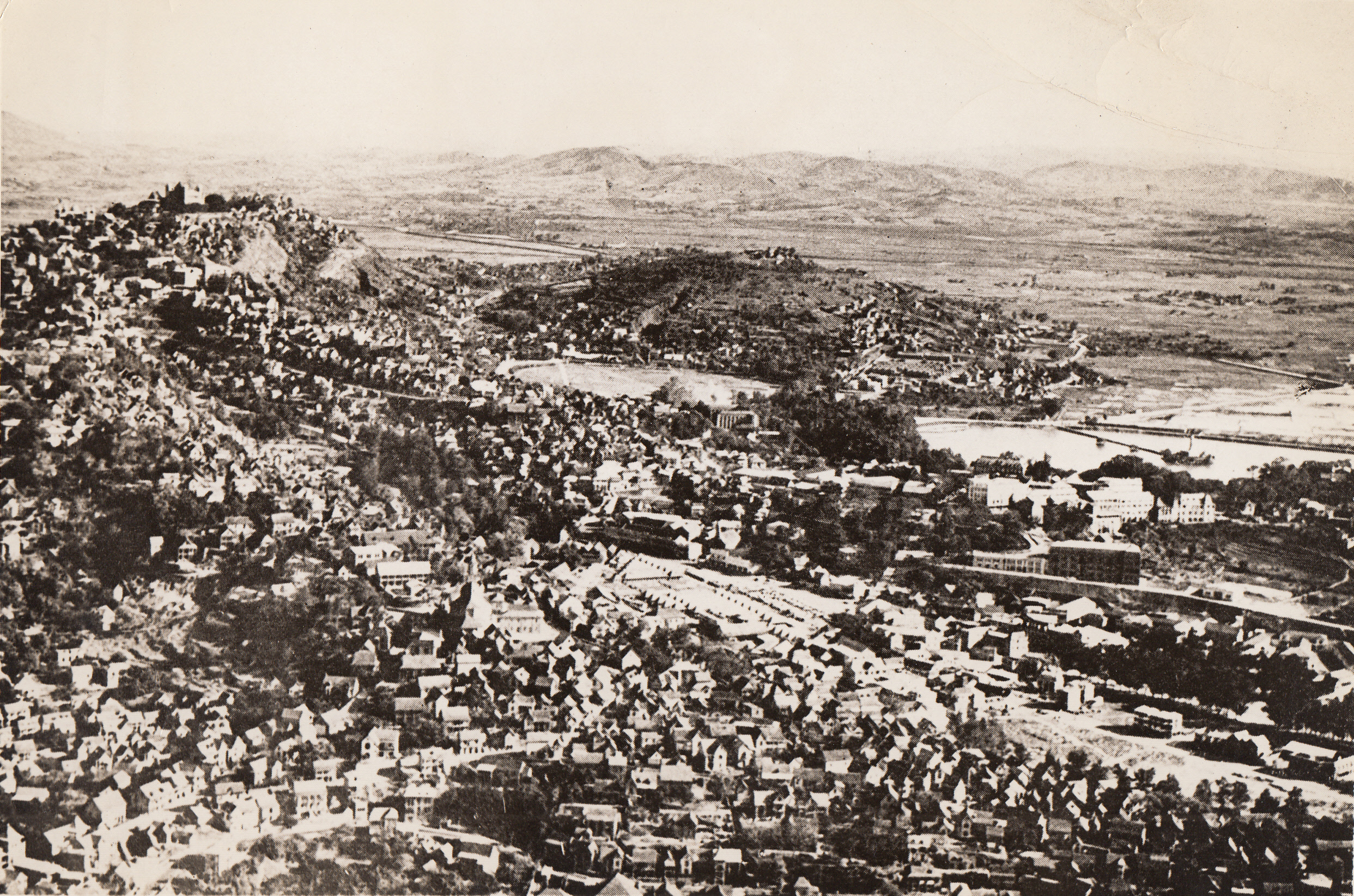
Air View of Island French Will Fight to Defend, 2/18/1942. Washington, D.C.—An air view of Tananarive, capital of the island of Madagascar, which French ambassador Gaston Henry-Haye denied in Washington, Feb. 18, would be turned over to the Japanese. The ambassador said such rumors were “without the slightest foundation” and that France would fight to defend the island, which is off the east coast of South Africa.;
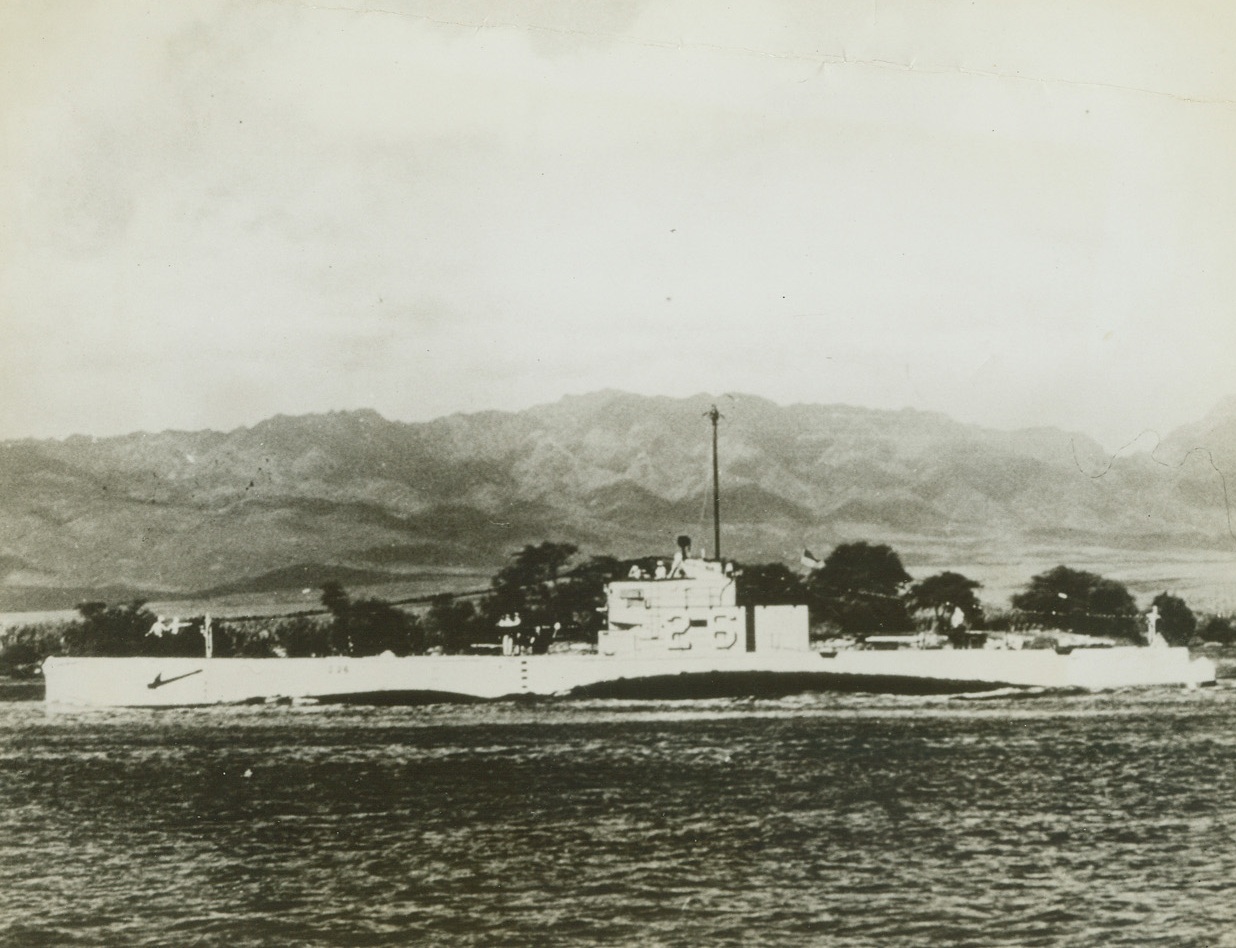
U.S. Sub Sank in Collision, 2/7/1942. Washington, D.C.—The U.S. Navy on Feb. 7th announced that the United States submarine S-26 was sunk in a collision with another U.S. Naval vessel on the night of Jan 24th off Panama. There were three survivors. There were thrown clear of the bridge when the ships collided. Other members of the crew perished. Photo shows the United States Submarine S-26.Credit: U.S. Navy official photo from ACME.;
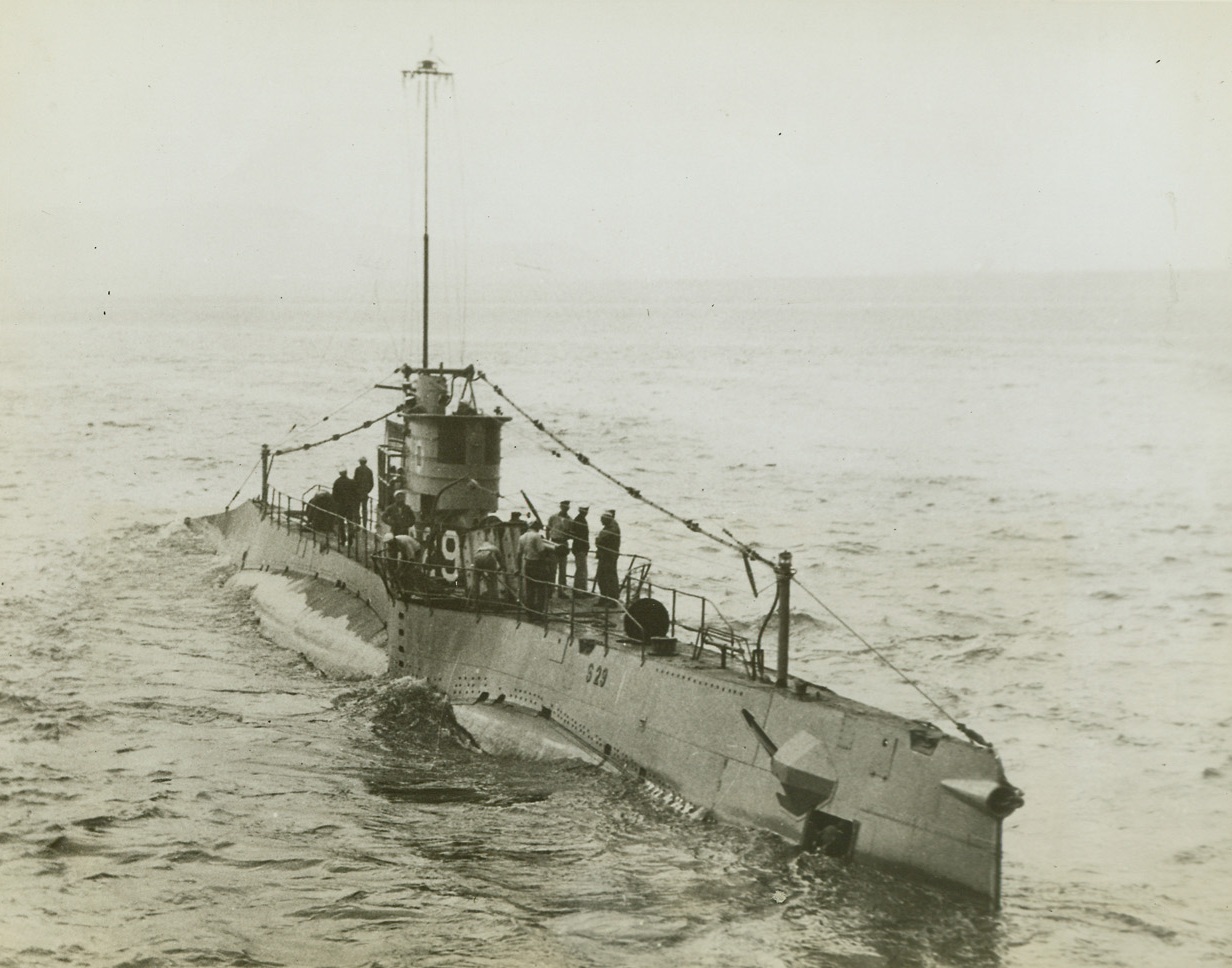
U.S. Sub Sank in Collision, 2/7/1942. Washington—Secretary of the Navy Frank Knox announced today that the U.S. Submarine S-26 was sunk in a collision with another U.S. Naval vessel on the night of Jan. 24th off Panama in 301 feet of water. There were three survivors, who were thrown clear off the bridge. Here is a view of the S-29, which is of the same class as the stricken ship. This craft usually carries some 38 officers and men, indicating a loss of about 35.Credit: ACME.;
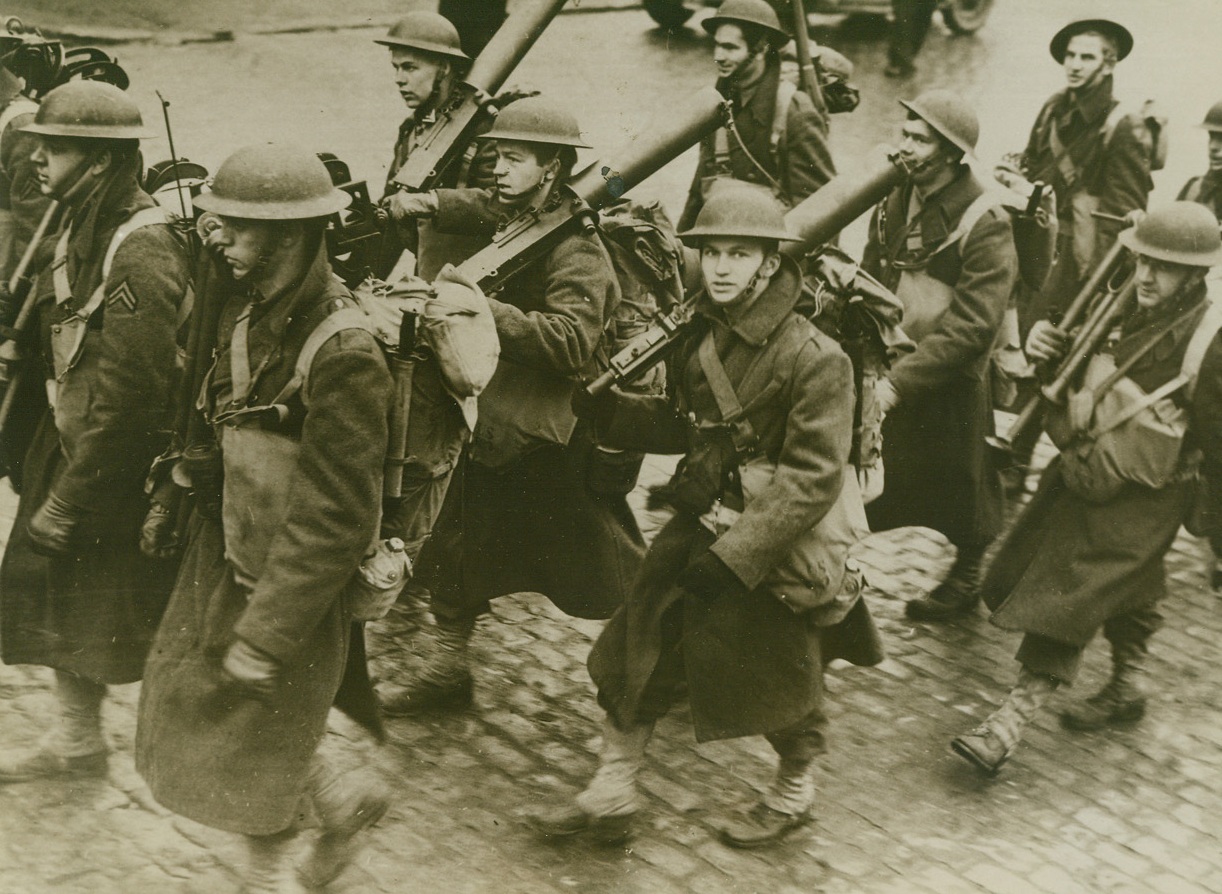
U.S. Troops Come Prepared, 2/8/1942. Ulster, Northern Ireland - Carrying Machine Guns over their shoulders, U.S. soldiers of the First Expeditionary Force to land in the British Isles march down a street in an unnamed Ulster town toward their camp after debarking. Passed by censors and flown to the U.S. by Clipper. Credit: ACME;
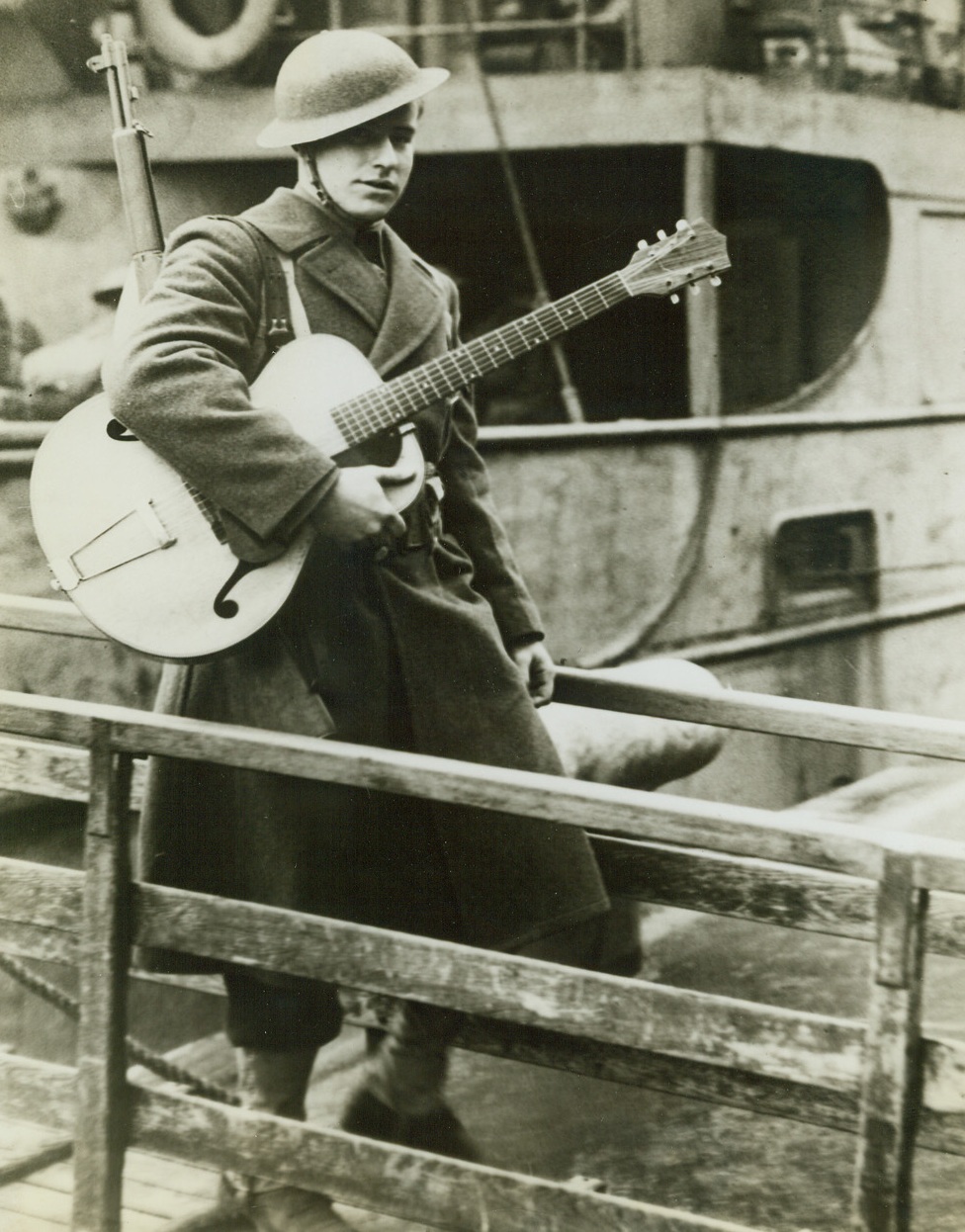
Takes His Music to Ireland, 2/8/1942. Northern Ireland - Pvt. Roy A. Brown, of Waterloo, Iowa, took his guitar along when he went to Northern Ireland with the first contingent of U.S. soldiers to set foot in the British Isles during World War II, and he carries it tenderly as he leaves the transport which brought him and his mates across the sub-infested Atlantic. Passed by Censors. Credit: ACME;
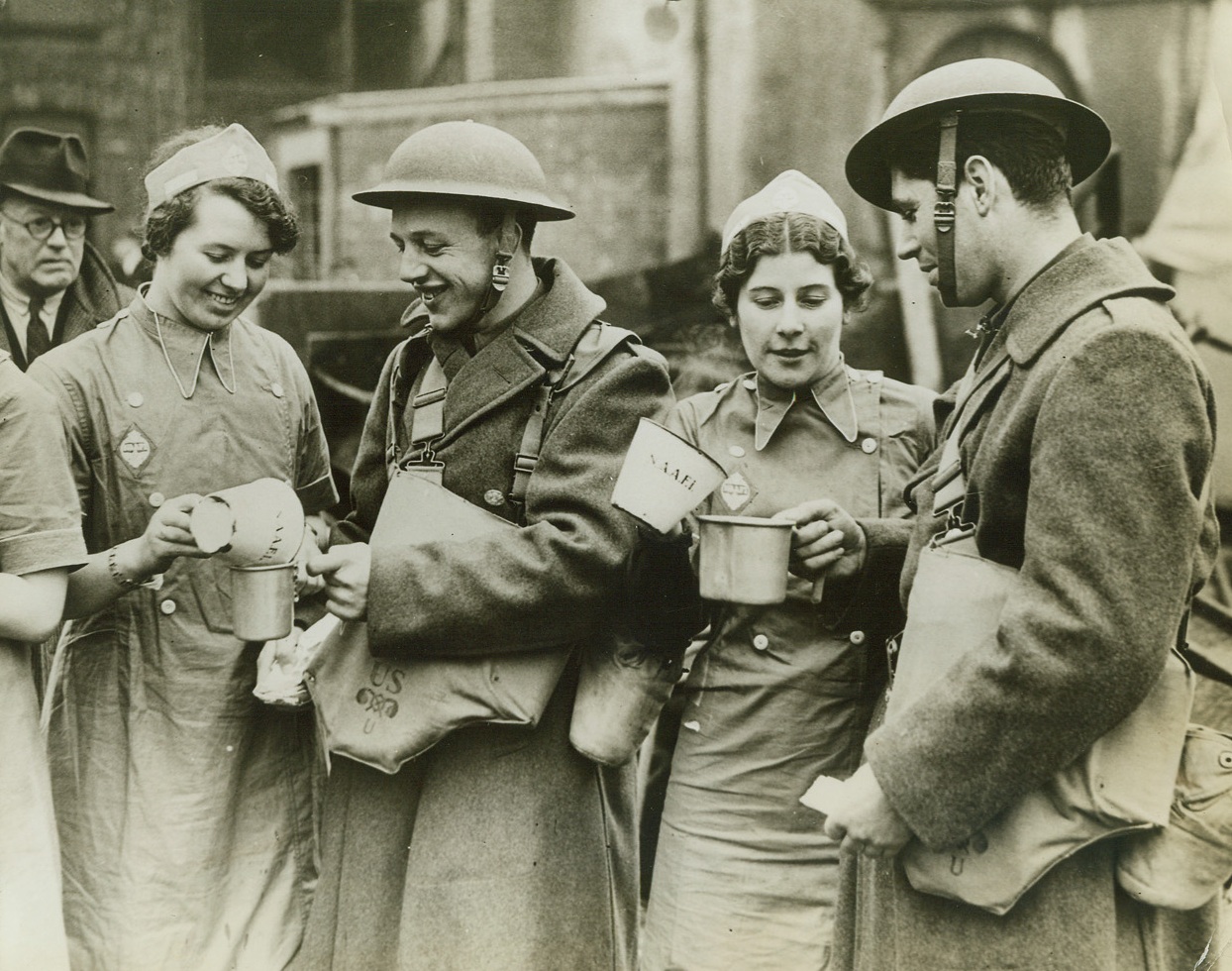
British Girls Pour Tea For Yanks, 2/8/1942. A Northern Irish Port - Girls of the NAAFI, as they poured tea for soldiers of the American Expeditionary Force, recently arrived in Northern Ireland.;
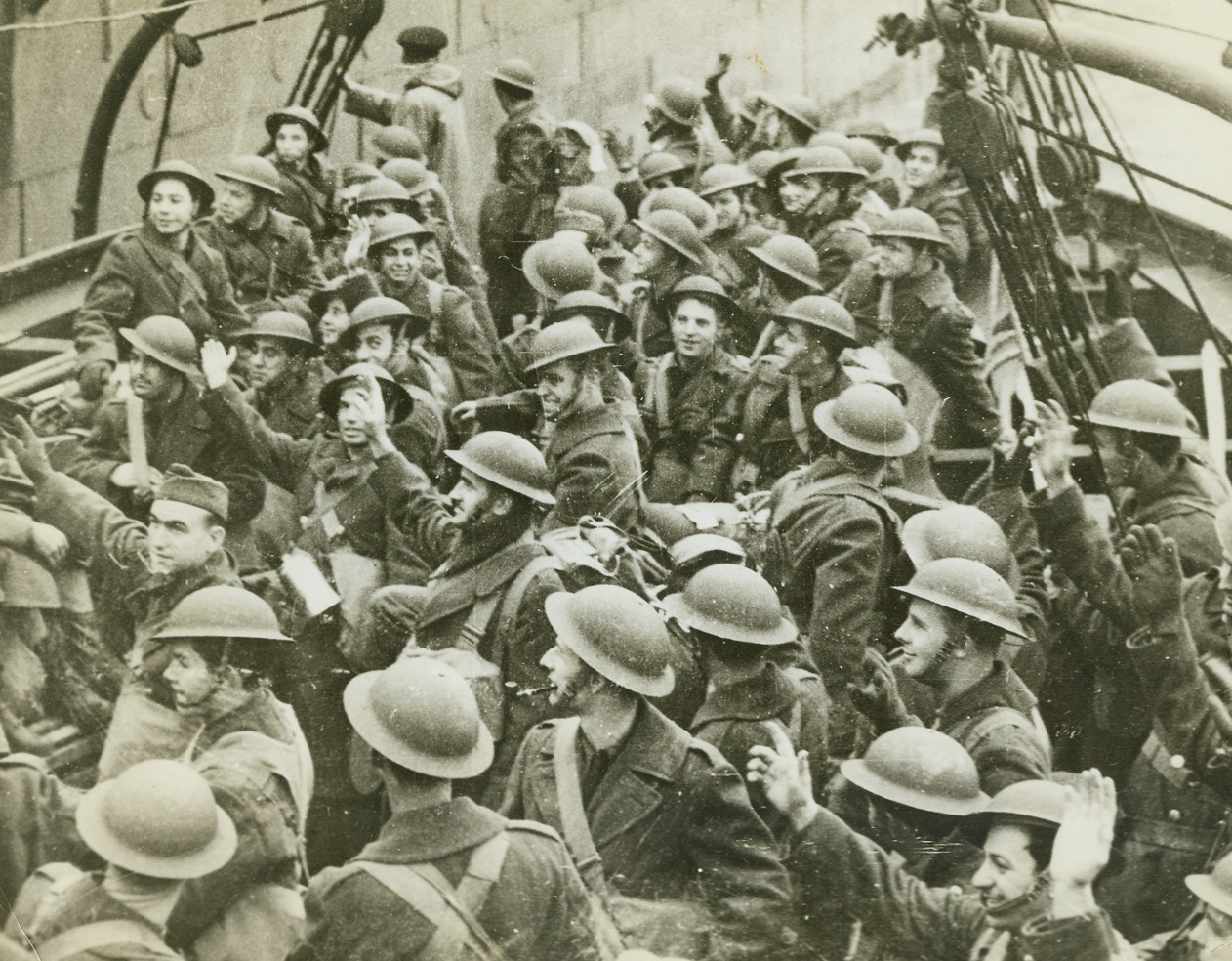
American Troops on Tender in Irish Port, 2/8/1942. In a Northern Irish Port -- American troops aboard a tender, on their way from a troopship to shore, recently, when the first A.E.F. to arrive in the British Isles during World War Two, reached “a northern Irish port.” Passed by censors. Credit: ACME;
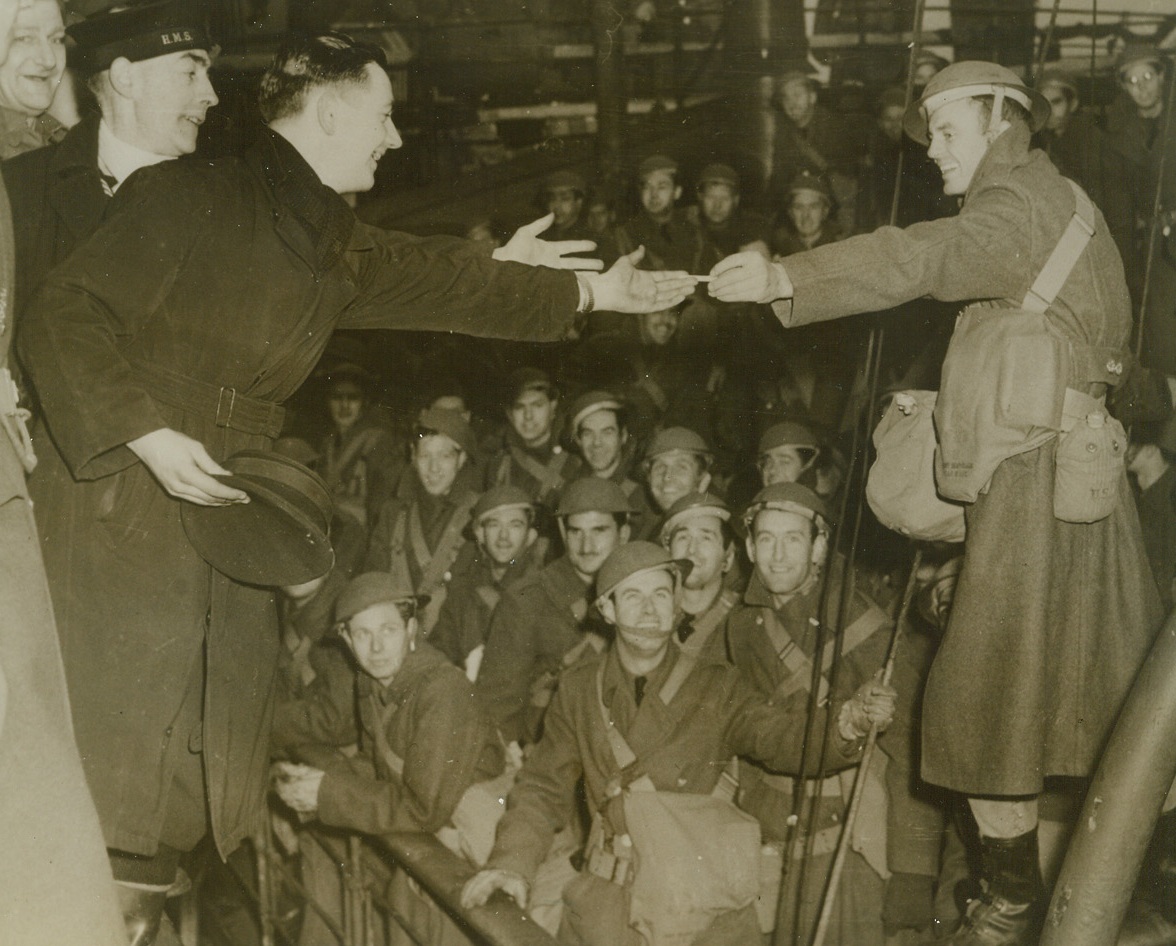
AMERICAN SOLDIERS REACH BRITISH ISLES, 2/8/1942. ULSTER, NORTHERN IRELAND—Workmen on dock in an unnamed Northern Ireland town greet members of the first U.S. expeditionary force arriving in the British Isles. Credit Line (ACME);
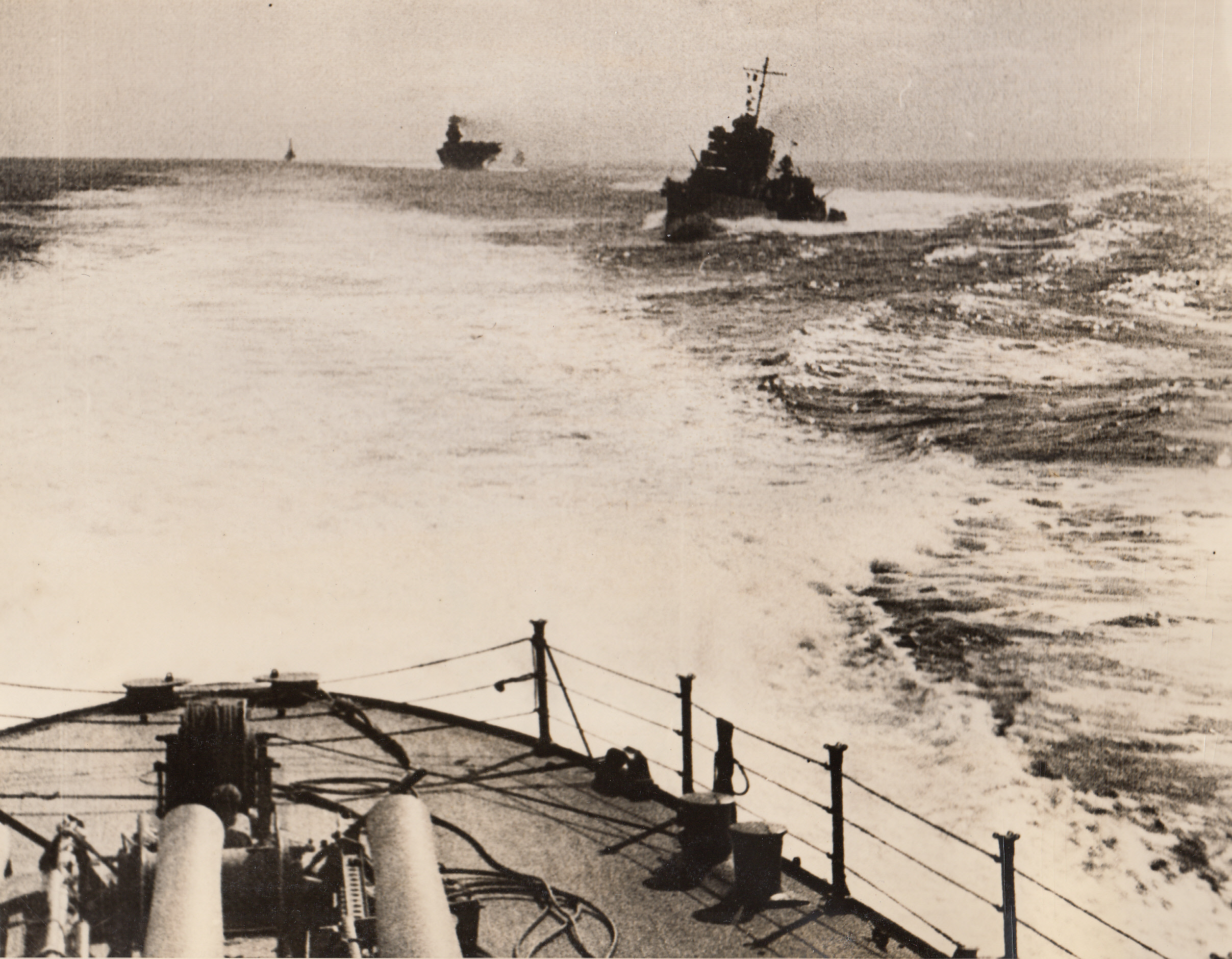
“The Fleet Is Not Idle . . .”, 2/14/1942. With the Pacific Fleet – Made from the deck of a U.S. warship, this photo shows other units of the Pacific Fleet, including an aircraft carrier in the background, speeding to the smashing attack on Japan’s Marshall and Gilbert Islands in the Western Pacific. Operations proceeded smoothly and before the U.S. warships retired they had smashed every enemy base, sunk numerous ships and downed 38 Jap planes, in partial repayment for Pearl Harbor.;





 Trash & Recycling
Trash & Recycling
 Online Payments
Online Payments
 City Documents
City Documents
 Parks
Parks
 Traffic Court
Traffic Court
 CITY PARKS
CITY PARKS
 Outdoor Recreation
Outdoor Recreation
 Volunteer
Volunteer
 Home
Home TRANSLATE
TRANSLATE
